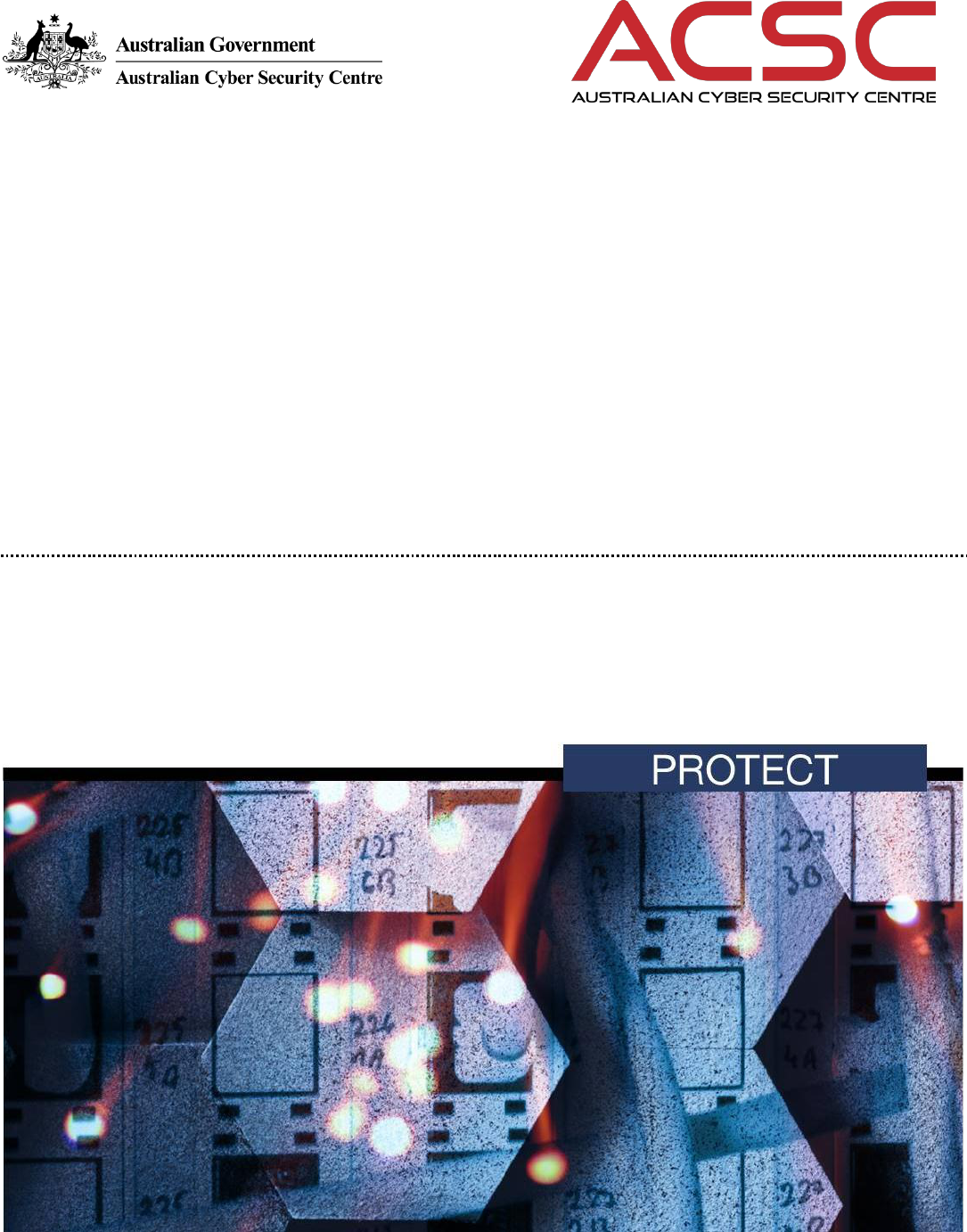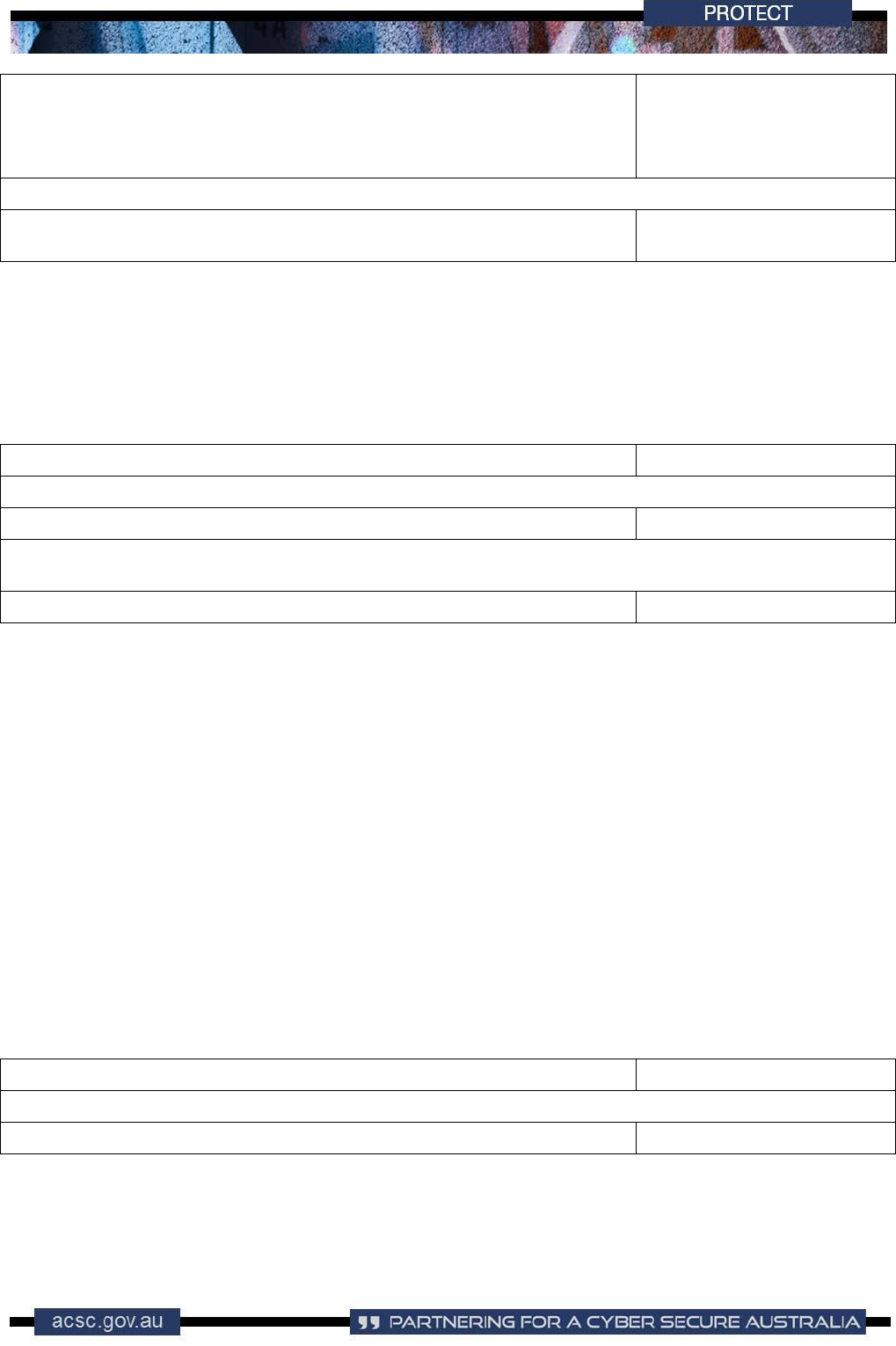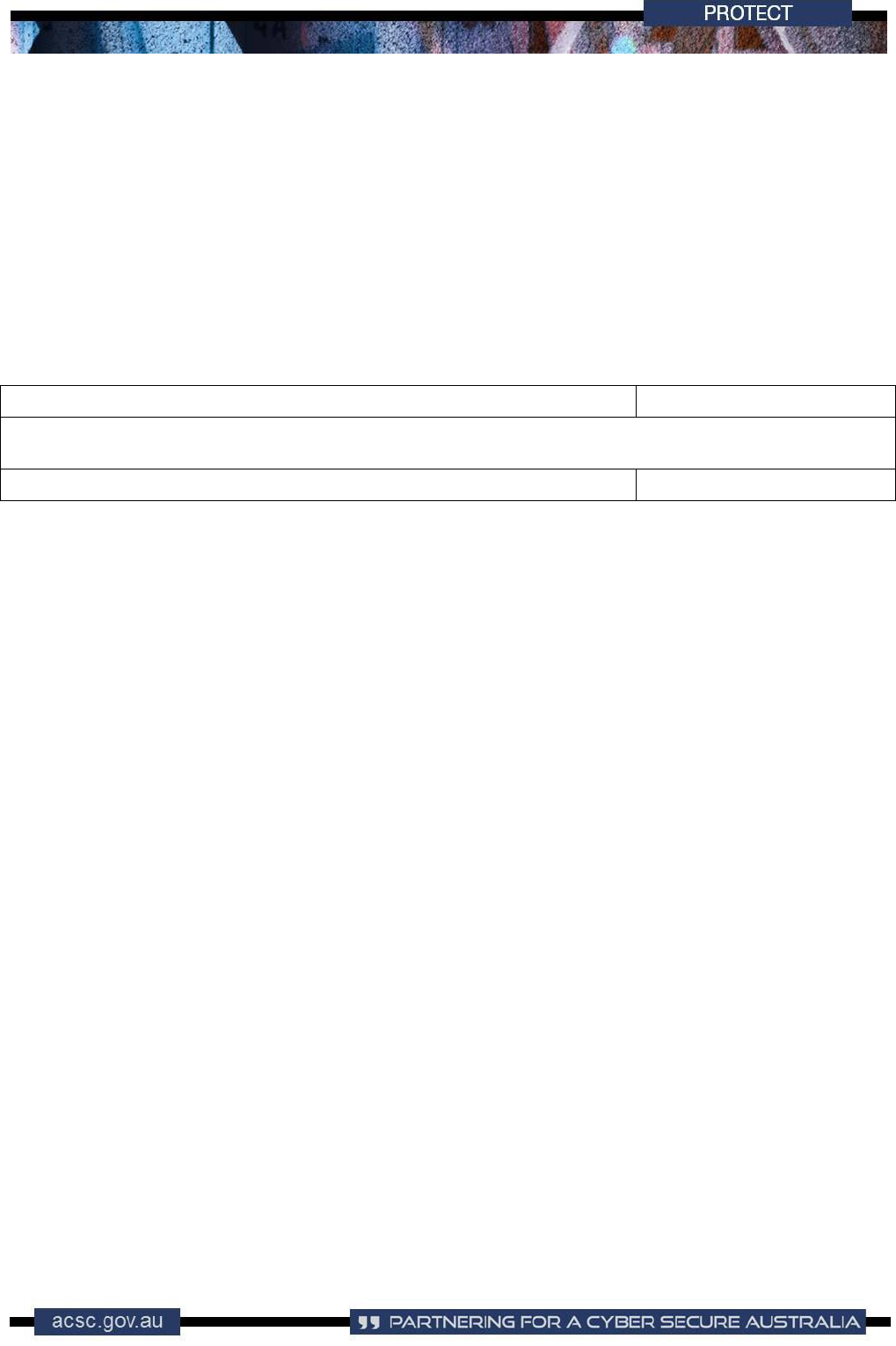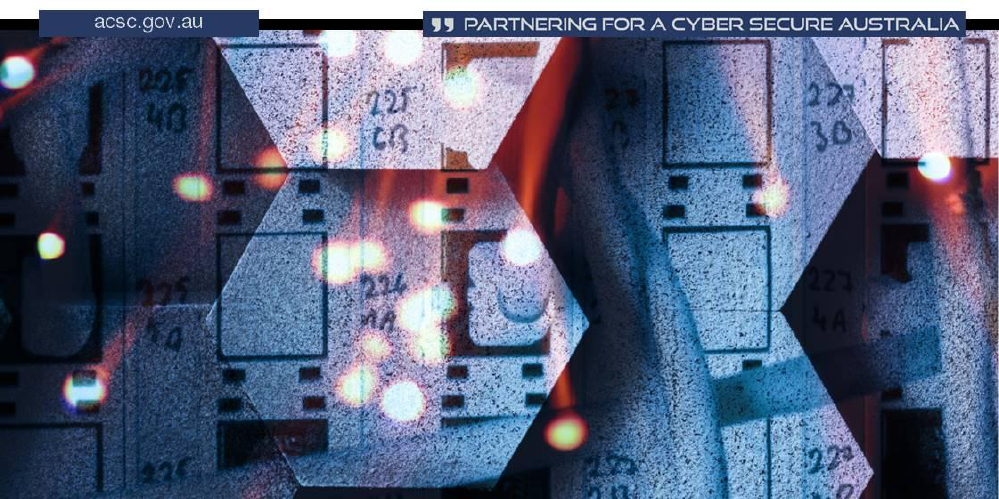
Hardening Microsoft Windows 10 version 1709 Workstations
May 2018

Page 2 of 54
CONTENTS
Introduction 5
High priorities 6
Application hardening 6
Application versions and patches 6
Application whitelisting 7
Attack Surface Reduction 9
Credential caching 10
Controlled Folder Access 11
Credential entry 12
Early Launch Antimalware 12
Elevating privileges 13
Exploit Protection 13
Local administrator accounts 14
Measured Boot 15
Microsoft Edge 15
Multi-factor authentication 16
Operating system architecture 16
Operating system patching 16
Password policy 18
Restricting privileged accounts 18
Secure Boot 18
Medium priorities 20
Account lockout policy 20
Anonymous connections 20
Antivirus software 21
Attachment Manager 22
Audit event management 23
Autoplay and AutoRun 24
BIOS and UEFI passwords 25
Boot devices 25
Bridging networks 25
Built-in guest accounts 26
Case locks 26
CD burner access 26
Centralised audit event logging 26

Page 3 of 54
Command Prompt 27
Direct Memory Access 27
Endpoint device control 28
File and print sharing 29
Group Policy processing 29
Hard drive encryption 30
Installing applications 34
Internet printing 35
Legacy and run once lists 35
Microsoft accounts 35
MSS settings 36
NetBIOS over TCP/IP 37
Network authentication 37
NoLMHash policy 37
Operating system functionality 38
Power management 38
PowerShell 39
Registry editing tools 39
Remote Assistance 40
Remote Desktop Services 40
Remote Procedure Call 42
Reporting system information 42
Safe Mode 43
Secure channel communications 43
Security policies 43
Server Message Block sessions 44
Session locking 45
Software-based firewalls 46
Sound Recorder 46
Standard Operating Environment 46
System backup and restore 46
System cryptography 47
User rights policies 47
Virtualised web and email access 48
Web Proxy Auto Discovery protocol 48
Windows Remote Management 48
Windows Remote Shell access 49
Windows Search and Cortana 49
Windows To Go 50

Page 5 of 54
Introduction
1. Workstations are often targeted by an adversary using malicious webpages, emails with
malicious attachments and removable media with malicious content in an attempt to extract
sensitive information. Hardening workstations is an important part of reducing this risk.
2. This document provides guidance on hardening workstations using Enterprise and Education
editions of Microsoft Windows 10 version 1709. Some Group Policy settings used in this
document may not be available or compatible with Professional, Home or S editions of Microsoft
Windows 10 version 1709.
3. While this document refers to workstations, most Group Policy settings are equally applicable to
servers (with the exception of Domain Controllers) using Microsoft Windows Server, version
1709 or Microsoft Windows Server 2016. The names and locations of Group Policy settings
used in this document are taken from Microsoft Windows 10 version 1709; some differences
exist for earlier versions of Microsoft Windows.
4. Before implementing recommendations in this document, thorough testing should be undertaken
to ensure the potential for unintended negative impacts on business processes is reduced as
much as possible.
5. This document is intended for information technology and information security professionals
within organisations looking to undertake risk assessments or vulnerability assessments as well
as those wishing to develop a hardened Standard Operating Environment for workstations.

Page 6 of 54
High priorities
6. The following security controls, listed in alphabetical order, are considered to have an excellent
effectiveness and should be treated as high priorities when hardening Microsoft Windows 10
version 1709 workstations.
Application hardening
7. When applications are installed they are often not pre-configured in a secure state. By default,
many applications enable functionality that isn’t required by any users while in-built security
functionality may be disabled or set at a lower security level. For example, Microsoft Office by
default allows untrusted macros in Office documents to automatically execute without user
interaction. To reduce this risk, applications should have any in-built security functionality
enabled and appropriately configured along with unrequired functionality disabled. This is
especially important for key applications such as office productivity suites (e.g. Microsoft Office),
PDF readers (e.g. Adobe Reader), web browsers (e.g. Microsoft Internet Explorer, Mozilla
Firefox or Google Chrome), common web browser plugins (e.g. Adobe Flash), email clients
(Microsoft Outlook) and software platforms (e.g. Oracle Java Platform and Microsoft .NET
Framework). In addition, vendors may provide guidance on configuring their products securely.
For example, Microsoft provides the Microsoft Office 2013 Security Guide as part of the
Microsoft Security Compliance Manager tool
1
. In such cases, vendor guidance should be
followed to assist in securely configuring their products.
8. The Australian Cyber Security Centre (ACSC) also provides guidance for hardening Microsoft
Office. For more information see Hardening Microsoft Office 2013
2
and Hardening Microsoft
Office 2016
3
.
Application versions and patches
9. While some vendors may release new application versions to address security vulnerabilities,
others may release patches. If new application versions and patches for applications are not
installed it can allow an adversary to easily compromise workstations. This is especially
important for key applications that interact with content from untrusted sources such as office
productivity suites (e.g. Microsoft Office), PDF readers (e.g. Adobe Reader), web browsers (e.g.
Microsoft Internet Explorer, Mozilla Firefox or Google Chrome), common web browser plugins
(e.g. Adobe Flash), email clients (Microsoft Outlook) and software platforms (e.g. Oracle Java
Platform and Microsoft .NET Framework). To reduce this risk, new application versions and
patches for applications should be applied in an appropriate timeframe as determined by the
severity of security vulnerabilities they address and any mitigating measures already in place. In
cases where a previous version of an application continues to receive support in the form of
patches it still should be upgraded to the latest version to receive the benefit of any new security
functionality; however, this may be done as soon as practical rather than within two days of
release.
10. For more information on determining the severity of security vulnerabilities and timeframes for
applying new application versions and patches for applications see Assessing Security
Vulnerabilities and Applying Patches
4
.
1
https://technet.microsoft.com/en-au/solutionaccelerators/cc835245.aspx
2
https://www.acsc.gov.au/publications/protect/Hardening_MS_Office_2013.pdf
3
https://www.acsc.gov.au/publications/protect/Hardening_MS_Office_2016.pdf
4
https://www.acsc.gov.au/publications/protect/Assessing_Security_Vulnerabilities_and_Applying_Patches.pdf

Page 7 of 54
Application whitelisting
11. An adversary can email malicious code, or host malicious code on a compromised website, and
use social engineering techniques to convince users into executing it on their workstation. Such
malicious code often aims to exploit security vulnerabilities in existing applications and doesn’t
need to be installed on the workstation to be successful. To reduce this risk, an application
whitelisting solution should be appropriately implemented. Application whitelisting when
implemented in its most effective form (e.g. using hashes for executables, dynamic link libraries,
scripts, installers and packaged apps) can be an extremely effective mechanism in not only
preventing malicious code from executing but also ensuring only authorised applications can be
installed on workstations. Less effective implementations of application whitelisting (e.g. using
approved paths for installed applications in combination with access controls requiring privileged
access to write to these locations) can be used as a first step towards implementing a more
comprehensive application whitelisting solution.
12. For more information on application whitelisting and how it can be appropriately implemented
see Implementing Application Whitelisting
5
.
13. If Microsoft AppLocker
6
is used for application whitelisting, the following rules can be used as a
sample path-based implementation. In support of this, the rules, enforcement of rules and the
automatic starting of the Application Identity service should be set via Group Policy at a domain
level
7
.
Whitelisting Rule
Recommended Value
Computer Configuration\Policies\Windows Settings\Security Settings\Application Control Policies\
AppLocker\DLL Rules
[Path] %ProgramFiles%\*
Allow Everyone
[Path] %WinDir%\*
Allow Everyone
Exceptions:
%System32%\spool\
drivers\color\*
%System32%\Tasks\*
%WinDir%\Tasks\*
%WinDir%\Temp\*
Computer Configuration\Policies\Windows Settings\Security Settings\Application Control Policies\
AppLocker\Executable Rules
[Path] %ProgramFiles%\*
Allow Everyone
[Path] %WinDir%\*
Allow Everyone
Exceptions:
%System32%\spool\
drivers\color\*
%System32%\Tasks\*
5
https://www.acsc.gov.au/publications/protect/Application_Whitelisting.pdf
6
https://technet.microsoft.com/en-us/library/hh831409(v=ws.11).aspx
7
https://technet.microsoft.com/en-au/library/ee844118.aspx

Page 8 of 54
[Path] %WinDir%\* (continued)
%WinDir%\Tasks\*
%WinDir%\Temp\*
Computer Configuration\Policies\Windows Settings\Security Settings\Application Control Policies\
AppLocker\Packaged app Rules
[Publisher] CN=Microsoft Corporation, O=Microsoft Corporation, L-Redmond,
S=Washington, C=US
Allow Everyone
Computer Configuration\Policies\Windows Settings\Security Settings\Application Control Policies\
AppLocker\Script Rules
[Path] %ProgramFiles%\*
Allow Everyone
[Path] %WinDir%\*
Allow Everyone
Exceptions:
%System32%\Com\dmp\*
%System32%\FxsTmp\*
%System32%\spool\
drivers\color\*
%System32%\spool\PRINTER
S\*
%System32%\spool\SERVER
S\*
%System32%\Tasks\*
%WinDir%\Registration\CRML
og\*
%WinDir%\Tasks\*
%WinDir%\Temp\*
%WinDir%\tracing\*
Computer Configuration\Policies\Windows Settings\Security Settings\Application Control Policies\
AppLocker\Windows Installer Rules
[Publisher] CN=Microsoft Corporation, O=Microsoft Corporation, L-Redmond,
S=Washington, C=US
Allow Everyone
14. Note, for those organisations using the latest version of Microsoft Windows 10 (i.e. version
1709), the following paths no longer need to be included as exceptions:
a. %WinDir%\servicing\Packages\*
b. %WinDir%\servicing\Sessions\*.
15. A new security feature introduced in Microsoft Windows 10 is Device Guard
8
. Device Guard uses
a Code Integrity Policy to restrict what can run in both kernel mode and on the desktop based on
its policy. Device Guard also uses virtualisation to protect itself from being disabled by an
adversary that has obtained administrative privileges. However, while Device Guard can
implement application whitelisting, organisations are likely to require an additional application
whitelisting solution to supplement Device Guard, especially if choosing to use a path-based
approach for application whitelisting.
16. If Device Guard is used for application whitelisting, the following Group Policy settings can be
implemented, assuming all software, firmware and hardware pre-requests are met.
8
https://docs.microsoft.com/en-au/windows/device-security/device-guard/device-guard-deployment-guide

Page 9 of 54
Group Policy Setting
Recommended Option
Computer Configuration\Policies\Administrative Templates\System\Device Guard
Deploy Windows Defender Application Control
Enabled
Code Integrity Policy file path:
<organisation defined>
Turn On Virtualization Based Security
Enabled
Virtualization Based Protection
of Code Integrity: Enabled with
UEFI lock
Attack Surface Reduction
17. Attack Surface Reduction (ASR)
9
is a new security feature introduced in Microsoft Windows 10
version 1709 as part of Windows Defender Exploit Guard. It is designed to combat the threat of
malware exploiting legitimate functionality in Microsoft Office applications. In order to use ASR,
Windows Defender Antivirus must be configured as the primary real-time antivirus scanning
engine on workstations.
18. ASR offers a number of attack surface reduction rules, these include:
a. block executable content from email client and webmail:
BE9BA2D9-53EA-4CDC-84E5-9B1EEEE46550
b. block Office applications from creating child processes:
D4F940AB-401B-4EFC-AADC-AD5F3C50688A
c. block Office applications from creating executable content:
3B576869-A4EC-4529-8536-B80A7769E899
d. block Office applications from injecting code into other processes:
75668C1F-73B5-4CF0-BB93-3ECF5CB7CC84
e. block JavaScript and VBScript from launching downloaded executable content:
D3E037E1-3EB8-44C8-A917-57927947596D
f. block execution of potentially obfuscated scripts:
5BEB7EFE-FD9A-4556-801D-275E5FFC04CC
g. block Win32 API calls from Office macro:
92E97FA1-2EDF-4476-BDD6-9DD0B4DDDC7B.
19. Organisations should either implement ASR using Windows Defender Antivirus or use 3
rd
party
antivirus solutions that offer similar security measures to those provided by ASR.
20. For organisations using Windows Defender Antivirus, the following Group Policy settings can be
implemented to enforce the above ASR rules.
9
https://docs.microsoft.com/en-au/windows/threat-protection/windows-defender-exploit-guard/attack-surface-
reduction-exploit-guard

Page 10 of 54
Group Policy Setting
Recommended Option
Computer Configuration\Policies\Administrative Templates\Windows Components\Windows Defender
Antivirus\Windows Defender Exploit Guard\Attack Surface Reduction
Configure Attack Surface Reduction rules
Enabled
Set the state for each ASR
rule:
75668c1f-73b5-4cf0-
bb93-3ecf5cb7cc84
1
3b576869-a4ec-4529-
8536-b80a7769e899
1
d4f940ab-401b-4efc-
aadc-ad5f3c50688a
1
92E97FA1-2EDF-4476-
BDD6-9DD0B4DDDC7B
1
5beb7efe-fd9a-4556-
801d-275e5ffc04cc
1
d3e037e1-3eb8-44c8-
a917-57927947596d
1
be9ba2d9-53ea-4cdc-
84e5-9b1eeee46550
1
Credential caching
21. Cached credentials are stored in the Security Accounts Manager (SAM) database and can allow
a user to log onto a workstation they have previously logged onto even if the domain is not
available. Whilst this functionality may be desirable from an availability of services perspective,
this functionality can be abused by an adversary who can retrieve these cached credentials
(potentially Domain Administrator credentials in a worst-case scenario). To reduce this risk,
cached credentials should be limited to only one previous logon.
22. The following Group Policy settings can be implemented to disable credential caching.
Group Policy Setting
Recommended Option
Computer Configuration\Policies\Windows Settings\Security Settings\Local Policies\Security Options
Interactive logon: Number of previous logons to cache (in case domain
controller is not available)
1 logons
Network access: Do not allow storage of passwords and credentials for
network authentication
Enabled
23. Within an active user session, credentials are cached within the Local Security Authority
Subsystem Service (LSASS) process (including the user’s passphrase in plaintext if WDigest
authentication is enabled) to allow for access to network resources without users having to
continually enter their credentials. Unfortunately, these credentials are at risk of theft by an
adversary. To reduce this risk, WDigest authentication should be disabled.

Page 11 of 54
24. Credential Guard
10
, a new security feature of Microsoft Windows 10, is also designed to assist in
protecting the LSASS process.
25. The following Group Policy settings can be implemented to disable WDigest authentication and
enable Credential Guard functionality, assuming all software, firmware and hardware pre-
requests are met.
Group Policy Setting
Recommended Option
Computer Configuration\Policies\Administrative Templates\MS Security Guide
WDigest Authentication
Disabled
Computer Configuration\Policies\Administrative Templates\System\Device Guard
Turn On Virtualization Based Security
Enabled
Select Platform Security Level:
Secure Boot and DMA
Protection
Credential Guard
Configuration: Enabled with
UEFI lock
Controlled Folder Access
26. Controlled Folder Access
11
is a new security feature introduced in Microsoft Windows 10 version
1709 as part of Windows Defender Exploit Guard. It is designed to combat the threat of
ransomware.
27. In order to use Controlled Folder Access, Windows Defender Antivirus must be configured as
the primary real-time antivirus scanning engine on workstations. Other 3
rd
party antivirus
solutions may offer similar functionality as part of their offerings.
28. The following Group Policy settings can be implemented to implement Controlled Folder Access.
Group Policy Setting
Recommended Option
Computer Configuration\Policies\Administrative Templates\Windows Components\Windows Defender
Antivirus\Windows Defender Exploit Guard\Controlled Folder Access
Configure allowed applications
Enabled
Enter the applications that
should be trusted:
<organisation defined>
Configure Controlled folder access
Enabled
Configure the guard my
folders feature: Block
10
https://docs.microsoft.com/en-au/windows/access-protection/credential-guard/credential-guard
11
https://docs.microsoft.com/en-au/windows/threat-protection/windows-defender-exploit-guard/controlled-
folders-exploit-guard

Page 12 of 54
Configure protected folders
Enabled
Enter the folders that should
be guarded: <organisation
defined>
Credential entry
29. When users enter their credentials on a workstation it provides an opportunity for malicious
code, such as a key logging application, to capture the credentials. To reduce this risk, users
should be authenticated by using a trusted path to enter their credentials on the Secure Desktop.
30. The following Group Policy settings can be implemented to ensure credentials are entered in a
secure manner as well as prevent the disclosure of usernames of previous users.
Group Policy Setting
Recommended Option
Computer Configuration\Policies\Administrative Templates\System\Logon
Do not display network selection UI
Enabled
Enumerate local users on domain-joined computers
Disabled
Computer Configuration\Policies\Administrative Templates\Windows Components\Credential User
Interface
Do not display the password reveal button
Enabled
Enumerate administrator accounts on elevation
Disabled
Require trusted path for credential entry
Enabled
Computer Configuration\Policies\Administrative Templates\Windows Components\Windows Logon
Options
Disable or enable software Secure Attention Sequence
Disabled
Sign-in last interactive user automatically after a system-initiated restart
Disabled
Computer Configuration\Policies\Windows Settings\Security Settings\Local Policies\Security Options
Interactive logon: Do not require CTRL+ALT+DEL
Disabled
Interactive logon: Don’t display username at sign-in
Enabled
Early Launch Antimalware
31. Another key security feature of Trusted Boot supported by Microsoft Windows 10 and
motherboards with an UEFI is Early Launch Antimalware (ELAM) support. Used in conjunction
with Secure Boot, an ELAM driver can be registered as the first non-Microsoft driver that will be
initialised on a workstation as part of the boot process, thus allowing it to verify all subsequent
drivers before they are initialised. The ELAM driver is capable of allowing only known good
drivers to initialise; known good and unknown drivers to initialise; known good, unknown and bad
but critical drivers to initialise; or all drivers to initialise. To reduce the risk of malicious drivers,
only known good drivers should be allowed to be initialised during the boot process.
32. The following Group Policy setting can be implemented to ensure only known good drivers will
be initialised at boot time.

Page 13 of 54
Group Policy Setting
Recommended Option
Computer Configuration\Policies\Administrative Templates\System\Early Launch Antimalware
Boot-Start Driver Initialization Policy
Enabled
Choose the boot-start drivers
that can be initialized: Good
and unknown
Elevating privileges
33. Microsoft Windows provides the ability to require confirmation from users, via the User Access
Control (UAC) functionality, before any sensitive actions are performed. The default settings
allow privileged users to perform sensitive actions without first providing credentials and while
standard users must provide privileged credentials they are not required to do so via a trusted
path on the Secure Desktop. This provides an opportunity for an adversary that gains access to
an open session of a privileged user to perform sensitive actions at will or for malicious code to
capture any credentials entered via a standard user when attempting to elevate their privileges.
To reduce this risk, UAC functionality should be implemented to ensure all sensitive actions are
authorised by providing credentials on the Secure Desktop.
34. The following Group Policy settings can be implemented to configure UAC functionality
effectively.
Group Policy Setting
Recommended Option
Computer Configuration\Policies\Windows Settings\Security Settings\Local Policies\Security Options
User Account Control: Admin Approval Mode for the Built-in Administrator
account
Enabled
User Account Control: Allow UIAccess applications to prompt for elevation
without using the secure desktop
Disabled
User Account Control: Behavior of the elevation prompt for administrators in
Admin Approval Mode
Prompt for credentials on the
secure desktop
User Account Control: Behavior of the elevation prompt for standard users
Prompt for credentials on the
secure desktop
User Account Control: Detect application installations and prompt for elevation
Enabled
User Account Control: Only elevate UIAccess applications that are installed in
secure locations
Enabled
User Account Control: Run all administrators in Admin Approval Mode
Enabled
User Account Control: Switch to the secure desktop when prompting for
elevation
Enabled
User Account Control: Virtualize file and registry write failures to per-user
locations
Enabled
Exploit Protection
35. An adversary that develops exploits for Microsoft Windows or 3
rd
party applications will have a
higher success rate when security measures designed by Microsoft to help prevent security
vulnerabilities from being exploited are not implemented. Windows Defender Exploit Guard’s
Exploit Protection
12
functionality was introduced in Microsoft Windows 10 version 1709 to
12
https://docs.microsoft.com/en-au/windows/threat-protection/windows-defender-exploit-guard/exploit-protection-
exploit-guard

Page 14 of 54
provide system-wide and application-specific security measures. Exploit Protection is designed
to replace the Enhanced Mitigation Experience Toolkit (EMET) that was used on earlier versions
of Microsoft Windows 10.
36. System-wide security measures configurable via Exploit Protection include: Control Flow Guard
(CFG), Data Execution Prevention (DEP), mandatory Address Space Layout Randomization
(ASLR), bottom-up ASLR, Structured Exception Handling Overwrite Protection (SEHOP) and
heap corruption protection. Many more application-specific security measures are also available.
37. The following Group Policy settings can be implemented to define Exploit Protection settings and
to prevent users from modifying these settings on their devices.
Group Policy Setting
Recommended Option
Computer Configuration\Policies\Administrative Templates\Windows Components\Windows Defender
Exploit Guard\Exploit Protection
Use a common set of exploit protection settings
Enabled
Type the location (local path,
UNC path, or URL) of the
mitigation settings
configuration XML file:
<organisation defined>
Computer Configuration\Policies\Administrative Templates\Windows Components\Windows Defender
Security Center\App and browser protection
Prevent users from modifying settings
Enabled
38. In addition, the following Group Policy setting can be implemented to ensure DEP is not disabled
for File Explorer.
Group Policy Setting
Recommended Option
Computer Configuration\Policies\Administrative Templates\Windows Components\File Explorer
Turn off Data Execution Prevention for Explorer
Disabled
39. Furthermore, the following Group Policy setting can be implemented to force the use of SEHOP.
Group Policy Setting
Recommended Option
Computer Configuration\Policies\Administrative Templates\MS Security Guide
Enabled Structured Exception Handling Overwrite Protection (SEHOP)
Enabled
Local administrator accounts
40. When built-in administrator accounts are used with common account names and passwords it
can allow an adversary that compromises these credentials on one workstation to easily transfer
across the network to other workstations. Even if built-in administrator accounts are uniquely
named and have unique passwords, an adversary can still identify these accounts based on
their security identifier (i.e. S-1-5-21-domain-500
13
) and use this information to focus any
attempts to brute force credentials on a workstation if they can get access to the SAM database.
To reduce this risk, built-in administrator accounts should be disabled. Instead, domain accounts
with local administrative privileges, but without domain administrative privileges, should be used
for workstation management.
13
https://support.microsoft.com/en-au/help/243330/well-known-security-identifiers-in-windows-operating-systems

Page 15 of 54
41. The following Group Policy setting can be implemented to disable built-in administrator
accounts.
Group Policy Setting
Recommended Option
Computer Configuration\Policies\Windows Settings\Security Settings\Local Policies\Security Options
Accounts: Administrator account status
Disabled
42. If a common local administrator account absolutely must be used for workstation management
then Microsoft’s Local Administrator Password Solution (LAPS)
14
needs to be used to ensure
unique passphrases are used for each workstation. In addition, User Account Control restrictions
should be applied to remote connections using such accounts
15
.
Group Policy Setting
Recommended Option
Computer Configuration\Policies\Administrative Templates\MS Security Guide
Apply UAC restrictions to local accounts on network logons
Enabled
Measured Boot
43. The third key security feature of Trusted Boot supported by Microsoft Windows 10 and
motherboards with both an UEFI and a Trusted Processing Module (TPM) is Measured Boot.
Measured Boot is used to develop a reliable log of components that are initialised before the
ELAM driver. This information can then be scrutinised by antimalware software for signs of
tampering of boot components. To reduce the risk that malicious changes to boot components
go unnoticed, Measured Boot should be used on workstations that support it.
Microsoft Edge
44. Microsoft Edge is a web browser that was first introduced in Microsoft Windows 10 to replace
Internet Explorer. Microsoft Edge contains significant security enhancements over Internet
Explorer and should be used wherever possible.
45. Internet Explorer 11’s use should be restricted to supporting any legacy web applications hosted
on corporate intranets. If Internet Explorer 11 is not required, it should be uninstalled from
Microsoft Windows 10 to reduce the operating system’s attack surface.
46. For organisations using Microsoft Edge instead of 3
rd
party web browsers, the following Group
Policy settings can be implemented to harden Microsoft Edge.
Group Policy Setting
Recommended Option
Computer Configuration\Policies\Administrative Templates\Windows Components\Microsoft Edge
Allow Adobe Flash
Disabled
Allow Developer Tools
Disabled
Configure Do Not Track
Enabled
Configure Password Manager
Disabled
Configure Pop-up Blocker
Enabled
Configure Windows Defender SmartScreen
Enabled
14
https://www.microsoft.com/en-au/download/details.aspx?id=46899
15
https://support.microsoft.com/en-au/help/951016/description-of-user-account-control-and-remote-restrictions-
in-windows

Page 16 of 54
Prevent access to the about:flags page in Microsoft Edge
Enabled
Prevent bypassing Windows Defender SmartScreen prompts for files
Enabled
Prevent bypassing Windows Defender SmartScreen prompts for sites
Enabled
Computer Configuration\Policies\Administrative Templates\Windows Components\Windows Defender
Antivirus\Windows Defender Exploit Guard\Network Protection
Prevent users and apps from accessing dangerous websites
Enabled
Block
Computer Configuration\Policies\Administrative Templates\Windows Components\Windows Defender
Application Guard
Turn on Windows Defender Application Guard in Enterprise Mode
Enabled
Computer Configuration\Policies\Administrative Templates\Windows Components\Windows Defender
SmartScreen\Microsoft Edge
Configure Windows Defender SmartScreen
Enabled
Prevent bypassing Windows Defender SmartScreen prompts for sites
Enabled
Multi-factor authentication
47. As privileged credentials often allow users to bypass security functionality put in place to protect
workstations, and are susceptible to key logging applications, it is important that they are
appropriately protected against compromise. In addition, an adversary that brute forces captured
password hashes can gain access to workstations if multi-factor authentication hasn’t been
implemented. To reduce this risk, hardware-based multi-factor authentication should be used for
users as they perform a privileged action or access any important or sensitive data repositories.
48. For more information on how to effectively implement multi-factor authentication see Multi-factor
authentication
16
.
Operating system architecture
49. The x64 (64-bit) versions of Microsoft Windows include additional security functionality that the
x86 (32-bit) versions lack. This includes native hardware-based Data Execution Prevention
(DEP) kernel support, Kernel Patch Protection (PatchGuard), mandatory device driver signing
and lack of support for malicious 32-bit drivers. Using x86 (32-bit) versions of Microsoft Windows
exposes organisations to exploit techniques mitigated by x64 (64-bit) versions of Microsoft
Windows. To reduce this risk, workstations should use the x64 (64-bit) versions of Microsoft
Windows.
Operating system patching
50. Patches are released either in response to previously disclosed security vulnerabilities or to
proactively address security vulnerabilities that have not yet been publicly disclosed. In the case
of disclosed security vulnerabilities, it is possible that exploits have already been developed and
are freely available in common hacking tools. In the case of patches for security vulnerabilities
that have not yet been publically disclosed, it is relatively easy for an adversary to use freely
available tools to identify the security vulnerability being patched and develop an associated
exploit. This activity can be undertaken in less than one day and has led to an increase in 1-day
attacks. To reduce this risk, operating system patches and driver updates should be centrally
managed and deployed in an appropriate timeframe as determined by the severity of the
16
https://www.acsc.gov.au/publications/protect/Multi_Factor_Authentication.pdf

Page 17 of 54
security vulnerability and any mitigating measures already in place. This can be achieved using
Microsoft System Center Configuration Manager (SCCM)
17
. Microsoft Windows Server Update
Services (WSUS)
18
can also centrally deploy patches but only for Microsoft applications.
51. For more information on determining the severity of security vulnerabilities and timeframes for
applying patches see Assessing Security Vulnerabilities and Applying Patches
19
.
52. The following Group Policy settings can be implemented to ensure operating systems remain
appropriately patched.
Group Policy Setting
Recommended Option
Computer Configuration\Policies\Administrative Templates\Windows Components\Windows Update
Allow Automatic Updates immediate installation
Enabled
Configure Automatic Updates
Enabled
Configure automatic updating:
4 - Auto download and
schedule the install
Schedule install day: 0 - Every
day
Install updates for other
Microsoft products
Do not include drivers with Windows Updates
Disabled
No auto-restart with logged on users for scheduled automatic updates
installations
Enabled
Remove access to use all Windows Update features
Disabled
Turn on recommended updates via Automatic Updates
Enabled
53. Furthermore, if a Windows Server Update Services (WSUS) server is used, the following Group
Policy setting can be implemented.
Group Policy Setting
Recommended Option
Computer Configuration\Policies\Administrative Templates\Windows Components\Windows Update
Specify intranet Microsoft update service location
Enabled
Set the intranet update service
for detecting updates:
<server:port>
54. Alternatively, if System Centre Configuration Manager (SCCM) is used instead of Microsoft
update servers or a WSUS server, equivalent settings can be implemented to achieve a similar
outcome.
17
https://www.microsoft.com/en-au/cloud-platform/system-center-configuration-manager
18
https://docs.microsoft.com/en-us/windows-server/administration/windows-server-update-services/get-
started/windows-server-update-services-wsus
19
https://www.acsc.gov.au/publications/protect/Assessing_Security_Vulnerabilities_and_Applying_Patches.pdf

Page 18 of 54
Password policy
55. The use of weak passwords, such as eight character passwords with no complexity, can allow
them to be brute forced within minutes using applications freely available on the Web. In
addition, having no maximum password age can allow an adversary to maintain extended
access to a workstation or network once a password has been compromised while having no
minimum password age can allow an adversary to recycle passwords if forced to change them
due to maximum password ages. To reduce this risk, a secure password policy should be
implemented.
56. The following Group Policy settings can be implemented to achieve a secure password policy.
Group Policy Setting
Recommended Option
Computer Configuration\Policies\Administrative Templates\System\Logon
Turn off picture password sign-in
Enabled
Turn on convenience PIN sign-in
Disabled
Computer Configuration\Policies\Windows Settings\Security Settings\Account Policies\Password Policy
Enforce password history
8 passwords remembered
Maximum password age
90 days
Minimum password age
1 days
Minimum password length
10 characters
Password must meet complexity requirements
Enabled
Store passwords using reversible encryption
Disabled
Computer Configuration\Policies\Windows Settings\Security Settings\Local Policies\Security Options
Accounts: Limit local account use of blank passwords to console logon only
Enabled
Restricting privileged accounts
57. Providing users with a privileged account for day to day usage poses a risk that they will use this
account for external web and email access. This is of particular concern as privileged users have
the ability to execute malicious code with privileged access rather than standard access. To
reduce this risk, users that don’t require privileged access should not be granted privileged
accounts while users that require privileged access should have separate standard and
privileged accounts with different credentials. In addition, any privileged accounts used should
have external web and email access blocked.
58. For more information on the use of privileged accounts and minimising their usage see
Restricting Administrative Privileges
20
.
Secure Boot
59. Another method for malicious code to maintain persistence and prevent detection is to replace
the default boot loader for Microsoft Windows with a malicious version. In such cases the
malicious boot loader executes at boot time and loads Microsoft Windows without any indication
that it is present. Such malicious boot loaders are extremely difficult to detect and can be used to
conceal malicious code on workstations. To reduce this risk, motherboards with Secure Boot
functionality should be used. Secure Boot, a component of Trusted Boot, is a security feature
supported by Microsoft Windows 10 and motherboards with an Unified Extensible Firmware
20
https://www.acsc.gov.au/publications/protect/Restricting_Admin_Privileges.pdf

Page 19 of 54
Interface (UEFI). Secure Boot works by checking at boot time that the boot loader is signed and
matches a Microsoft signed certificate stored in the UEFI. If the certificate signatures match the
boot loader is allowed to run, otherwise it is prevented from running and the workstation will not
boot.

Page 20 of 54
Medium priorities
60. The following security controls, listed in alphabetical order, are considered to have a very good
effectiveness and should be treated as medium priorities when hardening Microsoft Windows 10
version 1709 workstations.
Account lockout policy
61. Allowing unlimited attempts to access workstations will fail to prevent an adversary’s attempts to
brute force authentication measures. To reduce this risk, accounts should be locked out after a
defined number of invalid authentication attempts. The threshold for locking out accounts does
not need to be overly restrictive in order to be effective. For example, a threshold of 5 incorrect
attempts, with a reset period of 15 minutes for the lockout counter, will prevent any brute force
attempt while being unlikely to lock out a legitimate user who accidently enters their password
incorrectly a few times.
62. The following Group Policy settings can be implemented to achieve a reasonable lockout policy.
Group Policy Setting
Recommended Option
Computer Configuration\Policies\Windows Settings\Security Settings\Account Policies\Account Lockout
Policy
Account lockout duration
0
Account lockout threshold
5 invalid logon attempts
Reset account lockout counter after
15 minutes
Anonymous connections
63. An adversary can use anonymous connections to gather information about the state of
workstations. Information that can be gathered from anonymous connections (i.e. using the net
use command to connect to the IPC$ share) can include lists of users and groups, SIDs for
accounts, lists of shares, workstation policies, operating system versions and patch levels. To
reduce this risk, anonymous connections to workstations should be disabled.
64. The following Group Policy settings can be implemented to disable the use of anonymous
connections.
Group Policy Setting
Recommended Option
Computer Configuration\Policies\Administrative Templates\Network\Lanman Workstation
Enable insecure guest logons
Disabled
Computer Configuration\Policies\Windows Settings\Security Settings\Local Policies\Security Options
Network access: Allow anonymous SID/Name translation
Disabled
Network access: Do not allow anonymous enumeration of SAM accounts
Enabled
Network access: Do not allow anonymous enumeration of SAM accounts and
shares
Enabled
Network access: Let Everyone permissions apply to anonymous users
Disabled
Network access: Restrict anonymous access to Named Pipes and Shares
Enabled
Network access: Restrict clients allowed to make remote calls to SAM
O:BAG:BAD:(A;;RC;;;BA)
Network security: Allow Local System to use computer identity for NTLM
Enabled
Network security: Allow LocalSystem NULL session fallback
Disabled

Page 21 of 54
Computer Configuration\Policies\Windows Settings\Security Settings\Local Policies\User Rights
Assignment
Access this computer from the network
Administrators
Remote Desktop Users
Deny access to this computer from the network
Guests
NT AUTHORITY\Local
Account
Antivirus software
65. An adversary can develop malicious code to exploit security vulnerabilities in software not
detected and remedied by vendors during testing. As significant time and effort is often involved
in the development of functioning and reliable exploits, an adversary will often reuse their
exploits as much as possible before being forced to develop new exploits. To reduce this risk,
endpoint security applications with signature-based antivirus functionality should be
implemented. In doing so, signatures should be updated at least on a daily basis.
66. Whilst using signature-based antivirus functionality can assist in reducing risk, they are only
effective when a particular piece of malicious code has already been profiled and signatures are
current. An adversary can create variants of known malicious code, or develop new unseen
malicious code, to bypass traditional signature-based detection mechanisms. To reduce this risk,
endpoint security applications with host-based intrusion prevention functionality, or equivalent
functionality leveraging cloud-based services, should also be implemented. In doing so, such
functionality should be set at the highest level available.
67. If using Microsoft’s Windows Defender Antivirus solution, the following Group Policy settings can
be implemented to optimally configure it.
Group Policy Setting
Recommended Option
Computer Configuration\Policies\Administrative Templates\Windows Components\Windows Defender
Antivirus
Turn off Windows Defender Antivirus
Disabled
Computer Configuration\Policies\Administrative Templates\Windows Components\Windows Defender
Antivirus\MAPS
Configure local setting override for reporting to Microsoft MAPS
Disabled
Configure the ‘Block at First Sight’ feature
Enabled
Join Microsoft MAPS
Enabled
Join Microsoft MAPS:
Advanced MAPS
Send file samples when further analysis is required
Enabled
Send file samples when
further analysis is required:
Send safe samples

Page 22 of 54
Computer Configuration\Policies\Administrative Templates\Windows Components\Windows Defender
Antivirus\MpEngine
Configure extended cloud check
Enabled
Specify the extended cloud
check time in seconds: 50
Select cloud protection level
Enabled
Select cloud blocking level:
High blocking level
or
High+ blocking level
Computer Configuration\Policies\Administrative Templates\Windows Components\Windows Defender
Antivirus\Quarantine
Configure removal of items from Quarantine folder
Disabled
Computer Configuration\Policies\Administrative Templates\Windows Components\Windows Defender
Antivirus\Real-time Protection
Scan all downloaded files and attachments
Enabled
Turn off real-time protection
Disabled
Turn on behavior monitoring
Enabled
Turn on process scanning whenever real-time protection is enabled
Enabled
Computer Configuration\Policies\Administrative Templates\Windows Components\Windows Defender
Antivirus\Scan
Allow users to pause scan
Disabled
Check for the latest virus and spyware definitions before running a scheduled
scan
Enabled
Scan archive files
Enabled
Scan packed executables
Enabled
Scan removable drives
Enabled
Turn on e-mail scanning
Enabled
Turn on heuristics
Enabled
Attachment Manager
68. The Attachment Manager within Microsoft Windows works in conjunction with applications such
as the Microsoft Office suite and Internet Explorer to help protect workstations from attachments
that have been received via email or downloaded from the Internet. The Attachment Manager
classifies files as high, medium or low risk based on the zone they originated from and the type
of file. Based on the risk to the workstation, the Attachment Manager will either issue a warning
to a user or prevent them from opening a file. If zone information is not preserved, or can be
removed, it can allow an adversary to socially engineer a user to bypass protections afforded by
the Attachment Manager. To reduce this risk, the Attachment Manager should be configured to
preserve and protect zone information for files.
69. The following Group Policy settings can be implemented to ensure zone information associated
with attachments is preserved and protected.

Page 23 of 54
Group Policy Setting
Recommended Option
User Configuration\Policies\Administrative Templates\Windows Components\Attachment Manager
Do not preserve zone information in file attachments
Disabled
Hide mechanisms to remove zone information
Enabled
Audit event management
70. Failure to capture and analyse security related audit events from workstations can result in
intrusions going unnoticed. In addition, the lack of such information can significantly hamper
investigations following a security incident. To reduce this risk, security related audit events from
workstations should be captured and routinely analysed.
71. The following Group Policy settings can be implemented to ensure security related audit events
are appropriately captured.
Group Policy Setting
Recommended Option
Computer Configuration\Policies\Administrative Templates\System\Audit Process Creation
Include command line in process creation events
Enabled
Computer Configuration\Policies\Administrative Templates\Windows Components\Event Log Service\
Application
Specify the maximum log file size (KB)
Enabled
Maximum Log Size (KB):
65536
Computer Configuration\Policies\Administrative Templates\Windows Components\Event Log Service\
Security
Specify the maximum log file size (KB)
Enabled
Maximum Log Size (KB):
2097152
Computer Configuration\Policies\Administrative Templates\Windows Components\Event Log Service\
System
Specify the maximum log file size (KB)
Enabled
Maximum Log Size (KB):
65536
Computer Configuration\Policies\Windows Settings\Security Settings\Local Policies\User Rights
Assignment
Manage auditing and security log
Administrators
72. Furthermore, the following Group Policy settings can be implemented to enable a
comprehensive auditing strategy.
Group Policy Setting
Recommended Option
Computer Configuration\Policies\Windows Settings\Security Settings\Advanced Audit Policy
Configuration\Audit Policies\Account Management
Audit Computer Account Management
Success and Failure
Audit Other Account Management Events
Success and Failure

Page 24 of 54
Audit Security Group Management
Success and Failure
Audit User Account Management
Success and Failure
Computer Configuration\Policies\Windows Settings\Security Settings\Advanced Audit Policy
Configuration\Audit Policies\Detailed Tracking
Audit Process Creation
Success
Audit Process Termination
Success
Computer Configuration\Policies\Windows Settings\Security Settings\Advanced Audit Policy
Configuration\Audit Policies\Logon/Logoff
Audit Account Lockout
Success
Audit Group Membership
Success
Audit Logoff
Success
Audit Logon
Success and Failure
Audit Other Logon/Logoff Events
Success and Failure
Audit Special Logon
Success and Failure
Computer Configuration\Policies\Windows Settings\Security Settings\Advanced Audit Policy
Configuration\Audit Policies\Object Access
Audit File Share
Success and Failure
Audit File System
Success and Failure
Audit Kernel Object
Success and Failure
Audit Other Object Access Events
Success and Failure
Audit Registry
Success and Failure
Computer Configuration\Policies\Windows Settings\Security Settings\Advanced Audit Policy
Configuration\Audit Policies\Policy Change
Audit Audit Policy Change
Success and Failure
Audit Other Policy Change Events
Success and Failure
Computer Configuration\Policies\Windows Settings\Security Settings\Advanced Audit Policy
Configuration\Audit Policies\System
Audit System Integrity
Success and Failure
Computer Configuration\Policies\Windows Settings\Security Settings\Local Policies\Security Options
Audit: Force audit policy subcategory settings (Windows Vista or later) to
override audit policy category settings
Enabled
Autoplay and AutoRun
73. When enabled, Autoplay will automatically begin reading from a drive or media source as soon
as it is used with a workstation, while AutoRun commands, generally in an autorun.inf file on the
media, can be used to automatically execute any file on the media without user interaction. This
functionality can be exploited by an adversary to automatically execute malicious code. To
reduce this risk, Autoplay and AutoRun functionality should be disabled.
74. The following Group Policy settings can be implemented to disable Autoplay and AutoRun
functionality.

Page 25 of 54
Group Policy Setting
Recommended Option
Computer Configuration\Policies\Administrative Templates\Windows Components\AutoPlay Policies
Disallow Autoplay for non-volume devices
Enabled
Set the default behavior for AutoRun
Enabled
Default AutoRun Behavior: Do
not execute any autorun
commands
Turn off Autoplay
Enabled
Turn off Autoplay on: All drives
BIOS and UEFI passwords
75. An adversary with access to a workstation’s BIOS or UEFI can modify the hardware
configuration of the workstation to introduce attack vectors or weaken security functionality
within the workstation’s operating system. This can include disabling security functionality in the
CPU, modifying allowed boot devices and enabling insecure communications interfaces such as
FireWire and Thunderbolt. To reduce this risk, strong BIOS and UEFI passwords should be used
for all workstations to prevent unauthorised access.
Boot devices
76. By default, workstations are often configured to boot from optical media, or even USB media, in
preference to hard drives. An adversary with physical access to such workstations can boot from
their own media in order to gain access to the content of the hard drives. With this access, an
adversary can reset local user account passwords or gain access to the local SAM database to
steal password hashes for offline brute force cracking attempts. To reduce this risk, workstations
should be restricted to only booting from the designated primary system drive.
Bridging networks
77. When workstations have multiple network interfaces, such as an Ethernet interface and a
wireless interface, it is possible to establish a bridge between the connected networks. For
example, when using an Ethernet interface to connect to an organisation’s wired network and a
wireless interface to connect to another non-organisation controlled network such as a public
wireless hotspot. When bridges are created between such networks an adversary can directly
access the wired network from the wireless network to extract sensitive information. To reduce
this risk, the ability to install and configure network bridges between different networks should be
disabled. This won’t prevent an adversary from compromising a workstation via the wireless
network and then using malicious software as a medium to indirectly access the wired network.
This can only be prevented by manually disabling all wireless interfaces when connecting to
wired networks.
78. The following Group Policy settings can be implemented to disable the ability to install and
configure network bridges.
Group Policy Setting
Recommended Option
Computer Configuration\Policies\Administrative Templates\Network\Network Connections
Prohibit installation and configuration of Network Bridge on your DNS domain
network
Enabled

Page 26 of 54
Route all traffic through the internal network
Enabled
Select from the following
states: Enabled State
Computer Configuration\Policies\Administrative Templates\Network\Windows Connection Manager
Prohibit connection to non-domain networks when connected to domain
authenticated network
Enabled
Built-in guest accounts
79. When built-in guest accounts are used, it can allow an adversary to log onto a workstation over
the network without first needing to compromise legitimate user credentials. To reduce this risk,
built-in guest accounts should be disabled.
80. The following Group Policy settings can be implemented to disable and rename built-in guest
accounts.
Group Policy Setting
Recommended Option
Computer Configuration\Policies\Windows Settings\Security Settings\Local Policies\Security Options
Accounts: Guest account status
Disabled
Computer Configuration\Policies\Windows Settings\Security Settings\Local Policies\User Rights
Assignment
Deny log on locally
Guests
Case locks
81. Without the use of case locks an adversary can gain physical access to the insides of a
workstation. An adversary with this access can install or remove hardware, remove and replace
the CMOS battery to reset the BIOS or UEFI to default settings (i.e. no password), or temporarily
remove hard drives to create copies for offline analysis at a later date. To reduce this risk, case
locks should be used on workstations to prevent an adversary from gaining unauthorised
access.
CD burner access
82. If CD burning functionality is enabled, and CD burners are installed in workstations, an
adversary may attempt to steal sensitive information by burning it to CD. To reduce this risk,
users should not have access to CD burning functionality except when explicitly required.
83. The following Group Policy setting can be implemented to prevent access to CD burning
functionality, although as this Group Policy setting only prevents access to native CD burning
functionality in Microsoft Windows, users should also be prevented from installing 3
rd
party CD
burning applications. Alternatively, CD readers can be used in workstations instead of CD
burners.
Group Policy Setting
Recommended Option
User Configuration\Policies\Administrative Templates\Windows Components\File Explorer
Remove CD Burning features
Enabled
Centralised audit event logging
84. Storing audit event logs on workstations poses a risk that an adversary could attempt to modify
or delete these logs during an intrusion to cover their tracks. In addition, failure to conduct
centralised audit event logging will reduce the visibility of audit events across all workstations,

Page 27 of 54
prevent the correlation of audit events and increase the complexity of any investigations after
security incidents. To reduce this risk, audit event logs from workstations should be transferred
to a secure central logging server.
Command Prompt
85. An adversary who gains access to a workstation can use the Command Prompt to execute in-
built Microsoft Windows tools such as net and schtasks to gather information about the
workstation or domain as well as schedule malicious code to execute on other workstations on
the network. To reduce this risk, users should not have Command Prompt access or the ability
to execute batch files and scripts. Should a legitimate business requirement exist to allow users
to execute batch files (e.g. cmd and bat files); run logon, logoff, startup or shutdown batch file
scripts; or use Remote Desktop Services, this risk will need to be accepted.
86. The following Group Policy setting can be implemented to prevent access to the Command
Prompt and script processing functionality.
Group Policy Setting
Recommended Option
User Configuration\Policies\Administrative Templates\System
Prevent access to the command prompt
Enabled
Disable the command prompt
script processing also: Yes
Direct Memory Access
87. Communications interfaces that use Direct Memory Access (DMA) can allow an adversary with
physical access to a workstation to directly access the contents of a workstation’s memory. This
can be used to read sensitive contents such as cryptographic keys or to write malicious code
directly into memory. To reduce this risk, communications interfaces that allow DMA (e.g.
FireWire and Thunderbolt) should be disabled. This can be achieved either physically (e.g. using
epoxy) or by using software controls
21
(e.g. disabling the functionality in the Basic Input/Output
System (BIOS) or UEFI; removing the SBP-2 driver and disabling the Thunderbolt controller; or
using an end point protection solution).
88. The following Group Policy settings can be implemented to remove the SBP-2 driver and disable
the Thunderbolt controller.
Group Policy Setting
Recommended Option
Computer Configuration\Policies\Administrative Templates\System\Device Installation\Device
Installation Restrictions
Prevent installation of devices that match any of these device IDs
Enabled
Prevent installation of devices
that match any of these
Device IDs: PCI\CC_0C0A
Also apply to matching
devices that are already
installed.
21
https://support.microsoft.com/en-au/help/2516445/blocking-the-sbp-2-driver-and-thunderbolt-controllers-to-
reduce-1394-d

Page 28 of 54
Prevent installation of devices using drivers that match these device setup
classes
Enabled
Prevent installation of devices
using drivers for these device
setup classes:
{d48179be-ec20-11d1-b6b8-
00c04fa372a7}
Also apply to matching
devices that are already
installed.
Endpoint device control
89. An adversary with physical access to a workstation may attempt to connect unauthorised USB
media or other devices with mass storage functionality (e.g. smartphones, digital music players
or cameras) to facilitate malicious code infections or the unauthorised copying of sensitive
information. To reduce this risk, endpoint device control functionality should be appropriately
implemented to control the use of all removable storage devices.
90. The following Group Policy setting can be implemented to disable the use of removable storage
devices.
Group Policy Setting
Recommended Option
Computer Configuration\Policies\Administrative Templates\System\Removable Storage Access
All Removable Storage classes: Deny all access
Enabled
91. Alternatively, if specific classes of removable storage devices are required to meet business
requirements, the execute, read and write permissions should be controlled on a class by class
basis.
92. The following Group Policy settings provide a sample implementation that allows data to be read
from but not executed from or written to all classes of removable storage devices.
Group Policy Setting
Recommended Option
Computer Configuration\Policies\Administrative Templates\System\Removable Storage Access
CD and DVD: Deny execute access
Enabled
CD and DVD: Deny read access
Disabled
CD and DVD: Deny write access
Enabled
Custom Classes: Deny read access
Disabled
Custom Classes: Deny write access
Enabled
Floppy Drives: Deny execute access
Enabled
Floppy Drives: Deny read access
Disabled
Floppy Drives: Deny write access
Enabled
Removable Disks: Deny execute access
Enabled
Removable Disks: Deny read access
Disabled
Removable Disks: Deny write access
Enabled
Tape Drives: Deny execute access
Enabled
Tape Drives: Deny read access
Disabled

Page 29 of 54
Tape Drives: Deny write access
Enabled
WPD Devices: Deny read access
Disabled
WPD Devices: Deny write access
Enabled
File and print sharing
93. Users sharing files from their workstations can result in a lack of appropriate access controls
being applied to sensitive information and the potential for the propagation of malicious code
should file shares have read/write access. To reduce this risk, local file and print sharing should
be disabled. Ideally, sensitive information should be centrally managed (e.g. on a network share
with appropriate access controls). Disabling file and print sharing will not affect a user’s ability to
access shared drives and printers on a network.
94. The following Group Policy settings can be implemented to prevent users from sharing files.
Group Policy Setting
Recommended Option
Computer Configuration\Policies\Administrative Templates\Windows Components\HomeGroup
Prevent the computer from joining a homegroup
Enabled
User Configurations\Policies\Administrative Templates\Windows Components\Network Sharing
Prevent users from sharing files within their profile.
Enabled
Group Policy processing
95. Relying on users to set Group Policy settings for their workstations creates the potential for
users to inadvertently misconfigure or disable security functionality without consideration of the
impact on the security posture of the workstation. Alternatively, an adversary could exploit this to
disable any Local Group Policy settings that are hampering their efforts to extract sensitive
information. To reduce this risk, all audit, user rights and security related Group Policy settings
should be specified for workstations at an organisational unit or domain level. To ensure these
policies aren’t weakened, support for Local Group Policy settings should also be disabled.
96. The following Group Policy settings can be implemented to ensure only domain-based Group
Policy settings are applied to workstations.
Group Policy Setting
Recommended Option
Computer Configuration\Policies\Administrative Templates\Network\Network Provider
Hardened UNC Paths
Enabled
Hardened UNC Paths:
\\*\SYSVOL
RequireMutualAuthentication=
1, RequireIntegrity=1
\\*\NETLOGON
RequireMutualAuthentication=
1, RequireIntegrity=1

Page 30 of 54
Computer Configuration\Policies\Administrative Templates\System\Group Policy
Configure registry policy processing
Enabled
Process even if the Group
Policy objects have not
changed
Configure security policy processing
Enabled
Process even if the Group
Policy objects have not
changed
Turn off background refresh of Group Policy
Disabled
Turn off Local Group Policy Objects processing
Enabled
Hard drive encryption
97. An adversary with physical access to a workstation may be able to use a bootable CD/DVD or
USB media to load their own operating environment. From this environment, they can access
the local file system to gain access to sensitive information or the SAM database to access
password hashes. In addition, an adversary that gains access to a stolen or unsanitised hard
drive will be to recover its contents when connected to another machine on which they have
administrative access and can take ownership of files. To reduce this risk, 256-bit AES full disk
encryption should be used to protect the contents of hard drives from unauthorised access.
98. If Microsoft BitLocker is used, the following Group Policy settings should be implemented.
Group Policy Setting
Recommended Option
Computer Configuration\Policies\Administrative Templates\Windows Components\BitLocker Drive
Encryption
Choose drive encryption method and cipher strength (Windows 10 [Version
1511] and later)
Enabled
Select the encryption method
for operating system drives:
XTS-AES 256-bit
Select the encryption method
for fixed data drives: XTS-AES
256-bit
Select the encryption method
for removable data drives:
XTS-AES 256-bit
Disable new DMA devices when this computer is locked
Enabled
Prevent memory overwrite on restart
Disabled

Page 31 of 54
Computer Configuration\Policies\Administrative Templates\Windows Components\BitLocker Drive
Encryption\Fixed Data Drives
Choose how BitLocker-protected fixed drives can be recovered
Enabled
Allow data recovery agent
Configure user storage of
BitLocker recovery
information:
Allow 48-digit recovery
password
Allow 256-bit recovery key
Omit recovery options from
the BitLocker setup wizard
Save BitLocker recovery
information to AD DS for fixed
data drives
Configure storage of BitLocker
recovery information to AD
DS: Backup recovery
passwords and key packages
Do not enable BitLocker until
recovery information is stored
to AD DS for fixed data drives
Configure use of passwords for fixed data drives
Enabled
Require password for fixed
data drive
Configure password
complexity for fixed data
drives: Require password
complexity
Minimum password length for
fixed data drive: 10
Deny write access to fixed drives not protected by BitLocker
Enabled
Enforce drive encryption type on fixed data drives
Enabled
Select the encryption type:
Full encryption
Computer Configuration\Policies\Administrative Templates\Windows Components\BitLocker Drive
Encryption\Operating System Drives
Allow devices compliant with InstantGo or HSTI to opt out of pre-boot PIN.
Disabled
Allow enhanced PINs for startup
Enabled

Page 32 of 54
Allow network unlocked at startup
Enabled
Allow Secure Boot for integrity validation
Enabled
Choose how BitLocker-protected operating system drives can be recovered
Enabled
Allow data recovery agent
Configure user storage of
BitLocker recovery
information:
Allow 48-digit recovery
password
Allow 256-bit recovery key
Omit recovery options from
the BitLocker setup wizard
Save BitLocker recovery
information to AD DS for
operating system drives
Configure storage of BitLocker
recovery information to AD
DS: Backup recovery
passwords and key packages
Do not enable BitLocker until
recovery information is stored
to AD DS for operating system
drives
Configure minimum PIN length for startup
Enabled
Minimum characters: 13
Configure use of passwords for operating system drives
Enabled
Configure password
complexity for operating
system drives: Require
password complexity
Minimum password length for
operating system drive: 10
Disallow standard users from changing the PIN or password
Disabled
Enforce drive encryption type on operating system drives
Enabled
Select the encryption type:
Full encryption

Page 33 of 54
Require additional authentication at startup
Enabled
Allow BitLocker without a
compatible TPM (requires a
password or a startup key on
a USB flash drive)
Settings for computers with a
TPM
Configure TPM startup: Do not
allow TPM
Configure TPM startup PIN:
Allow startup PIN with TPM
Configure TPM startup key:
Allow startup key with TPM
Configure TPM startup key
and PIN: Allow startup key
and PIN with TPM
Reset platform validation data after BitLocker recovery
Enabled
Computer Configuration\Policies\Administrative Templates\Windows Components\BitLocker Drive
Encryption\Removable Data Drives
Choose how BitLocker-protected removable drives can be recovered
Enabled
Allow data recovery agent
Configure user storage of
BitLocker recovery
information:
Allow 48-digit recovery
password
Allow 256-bit recovery key
Omit recovery options from
the BitLocker setup wizard
Save BitLocker recovery
information to AD DS for
removable data drives
Configure storage of BitLocker
recovery information to AD
DS: Backup recovery
passwords and key packages

Page 34 of 54
Choose how BitLocker-protected removable drives can be recovered
(continued)
Do not enable BitLocker until
recovery information is stored
to AD DS for removable data
drives
Configure use of passwords for removable data drives
Enabled
Require password for
removable data drive
Configure password
complexity for removable data
drives: Require password
complexity
Minimum password length for
removable data drive: 10
Control use of BitLocker on removable drives
Enabled
Allow users to apply BitLocker
protection on removable data
drives
Deny write access to removable drives not protected by BitLocker
Enabled
Enforce drive encryption type on removable data drives
Enabled
Select the encryption type:
Full encryption
Installing applications
99. While the ability to install applications may be a business requirement for users, this privilege
can be exploited by an adversary. An adversary can email a malicious application, or host a
malicious application on a compromised website, and use social engineering techniques to
convince users into installing the application on their workstation. Even if privileged access is
required to install applications, users will use their privileged access if they believe, or can be
convinced that, the requirement to install the application is legitimate. Additionally, if applications
are configured to install using elevated privileges, an adversary can exploit this by creating a
Windows Installer installation package to create a new account that belongs to the local built-in
administrators group or to install a malicious application. To reduce this risk, all application
installations should be strictly controlled.
100. The following Group Policy settings can be implemented to control application installations.
Group Policy Setting
Recommended Option
Computer Configuration\Policies\Administrative Templates\Windows Components\File Explorer
Configure Windows Defender SmartScreen
Enabled
Pick one of the following
settings: Warn and prevent
bypass

Page 35 of 54
Computer Configuration\Policies\Administrative Templates\Windows Components\Windows Defender
SmartScreen\Explorer
Configure Windows Defender SmartScreen
Enabled
Pick one of the following
settings: Warn and prevent
bypass
Computer Configuration\Policies\Administrative Templates\Windows Components\Windows Installer
Allow user control over installs
Disabled
Always install with elevated privileges
Disabled
User Configuration\Policies\Administrative Templates\Windows Components\Windows Installer
Always install with elevated privileges
Disabled
Internet printing
101. Microsoft Windows has the ability to print to internet printers over HTTP. If not disabled, this
functionality could result in the accidental or intentional release of sensitive information into the
public domain. To reduce this risk, internet printing should be disabled.
102. The following Group Policy settings can be implemented to prevent the use of internet printing.
Group Policy Setting
Recommended Option
Computer Configuration\Policies\Administrative Templates\System\Internet Communication
Management\Internet Communication settings
Turn off downloading of print drivers over HTTP
Enabled
Turn off printing over HTTP
Enabled
Legacy and run once lists
103. Once malicious code has been copied to a workstation, an adversary with registry access can
remotely schedule it to execute (i.e. using the run once list) or to automatically execute each
time Microsoft Windows starts (i.e. using the legacy run list). To reduce this risk, legacy and run
once lists should be disabled. This may interfere with the operation of legitimate applications that
need to automatically execute each time Microsoft Windows starts. In such cases, the Run these
programs at user logon Group Policy setting can be used to perform the same function in a more
secure manner when defined at a domain level; however, if not used this Group Policy setting
should be disabled rather than left in its default undefined state.
104. The following Group Policy settings can be implemented to disable the use of legacy and run
once lists.
Group Policy Setting
Recommended Option
Computer Configuration\Policies\Administrative Templates\System\Logon
Do not process the legacy run list
Enabled
Do not process the run once list
Enabled
Run these programs at user logon
Disabled
Microsoft accounts
105. A feature of Microsoft Windows 10 is the ability to link Microsoft accounts (formerly Windows
Live IDs) to local or domain accounts. When this occurs, a user’s settings and files are stored in

Page 36 of 54
the cloud using OneDrive rather than locally or on a domain controller. While this may have the
benefit of allowing users to access their settings and files from any Microsoft Windows 10
workstation (e.g. corporate workstation, home PC, Internet café) it can also pose a risk to an
organisation as they lose control over where sensitive information may be accessed from. To
reduce this risk, users should not link Microsoft accounts with local or domain accounts.
106. The following Group Policy settings can be implemented to disable the ability to link Microsoft
accounts to local or domain accounts.
Group Policy Setting
Recommended Option
Computer Configuration\Policies\Administrative Templates\Windows Components\Microsoft account
Block all consumer Microsoft account user authentication
Enabled
Computer Configuration\Policies\Administrative Templates\Windows Components\OneDrive
Prevent the usage of OneDrive for file storage
Enabled
Computer Configuration\Policies\Windows Settings\Security Settings\Local Policies\Security Options
Accounts: Block Microsoft accounts
Users can’t add or log on with
Microsoft accounts
MSS settings
107. By failing to specify MSS specific registry values an adversary may be able to exploit
weaknesses in a workstation’s security posture to gain access to sensitive information. To
reduce this risk, MSS specific registry values that are still relevant to modern versions of
Microsoft Windows should be specified using Group Policy settings.
108. The Group Policy Administrative Templates for MSS specific registry values are available from
the Microsoft Security Guidance blog
22
. The ADMX and associated en-us ADML file can be
placed in %SystemDrive%\Windows\SYSVOL\domain\Policies\PolicyDefinitions on the Domain
Controller and they will automatically be loaded in the Group Policy Management Editor.
109. The following Group Policy settings can be implemented to configure MSS specific registry
values that are still relevant to modern versions of Microsoft Windows.
Group Policy Setting
Recommended Option
Computer Configuration\Policies\Administrative Templates\MSS (Legacy)
MSS: (DisableIPSourceRouting IPv6) IP source routing protection level
(protects against packet spoofing)
Enabled
DisableIPSourceRoutingIPv6:
Highest protection, source
routing is completely disabled
MSS: (DisableIPSourceRouting) IP source routing protection level (protects
against packet spoofing)
Enabled
DisableIPSourceRouting:
Highest protection, source
routing is completely disabled
MSS: (EnableICMPRedirect) Allow ICMP redirects to override OSPF generated
routes
Disabled
22
https://blogs.technet.microsoft.com/secguide/2016/10/02/the-mss-settings/

Page 37 of 54
MSS: (NoNameReleaseOnDemand) Allow the computer to ignore NetBIOS
name release requests except from WINS servers
Enabled
NetBIOS over TCP/IP
110. NetBIOS over TCP/IP facilitates a number of intrusion methods. To reduce this risk, NetBIOS
over TCP/IP should be disabled. As NetBIOS over TCP/IP is only used to support legacy
Microsoft Windows operating systems, such as those prior to Microsoft Windows 2000, there
shouldn’t be a business requirement for its use except in very rare circumstances. NetBIOS over
TCP/IP can be disabled by setting the NetBIOS settings under the IPv4 WINS settings on each
network interface to Disable NetBIOS over TCP/IP. NetBIOS over TCP/IP is not supported by
IPv6.
Network authentication
111. Using insecure network authentication methods may permit an adversary to gain unauthorised
access to network traffic and services. To reduce this risk, only secure network authentication
methods, ideally Kerberos, should be used for network authentication.
112. The following Group Policy settings can be implemented to configure Kerberos, and if required
for legacy purposes, the use of NTLMv2.
Group Policy Setting
Recommended Option
Computer Configuration\Policies\Windows Settings\Security Settings\Local Policies\Security Options
Network security: Configure encryption types allowed for Kerberos
AES128_HMAC_SHA1
AES256_HMAC_SHA1
Network security: LAN Manager authentication level
Send NTLMv2 response only.
Refuse LM & NTLM
Network security: Minimum session security for NTLM SSP based (including
secure RPC) clients
Require NTLMv2 session
security
Require 128-bit encryption
Network security: Minimum session security for NTLM SSP based (including
secure RPC) servers
Require NTLMv2 session
security
Require 128-bit encryption
NoLMHash policy
113. When Microsoft Windows hashes a password that is less than 15 characters, it stores both a
LAN Manager hash (LM hash) and Windows NT hash (NT hash) in the local SAM database for
local accounts, or in Activity Directory for domain accounts. The LM hash is significantly weaker
than the NT hash and can easily be brute forced. To reduce this risk, the NoLMHash Policy
should be implemented on all workstations and domain controllers. As the LM hash is designed
for authentication of legacy Microsoft Windows operating systems, such as those prior to
Microsoft Windows 2000, there shouldn’t be a business requirement for its use except in very
rare circumstances.
114. The following Group Policy setting can be implemented to prevent the storage of LM hashes for
passwords. All users should be encouraged to change their password once this Group Policy
setting has been set as until they do they will remain vulnerable.

Page 38 of 54
Group Policy Setting
Recommended Option
Computer Configuration\Policies\Windows Settings\Security Settings\Local Policies\Security Options
Network security: Do not store LAN Manager hash value on next password
change
Enabled
Operating system functionality
115. Leaving unneeded functionality in Microsoft Windows enabled can provide greater opportunities
for potentially vulnerable or misconfigured functionality to be exploited by an adversary. To
reduce this risk, unneeded functionality in Microsoft Windows should be disabled or removed.
Power management
116. One method of reducing power usage by workstations is to enter a sleep, hibernation or hybrid
sleep state after a pre-defined period of inactivity. When a workstation enters a sleep state it
maintains the contents of memory while powering down the rest of the workstation; with
hibernation or hybrid sleep, it writes the contents of memory to the hard drive in a hibernation file
(hiberfil.sys) and powers down the rest of the workstation. When this occurs, sensitive
information such as encryption keys could either be retained in memory or written to the hard
drive in a hibernation file. An adversary with physical access to the workstation and either the
memory or hard drive can recover the sensitive information using forensic techniques. To reduce
this risk, sleep, hibernation and hybrid sleep states should be disabled.
117. The following Group Policy settings can be implemented to ensure that sleep, hibernation and
hybrid sleep states are disabled.
Group Policy Setting
Recommended Option
Computer Configuration\Policies\Administrative Templates\System\Power Management\Sleep Settings
Allow standby states (S1-S3) when sleeping (on battery)
Disabled
Allow standby states (S1-S3) when sleeping (plugged in)
Disabled
Require a password when a computer wakes (on battery)
Enabled
Require a password when a computer wakes (plugged in)
Enabled
Specify the system hibernate timeout (on battery)
Enabled
System Hibernate Timeout
(seconds): 0
Specify the system hibernate timeout (plugged in)
Enabled
System Hibernate Timeout
(seconds): 0
Specify the system sleep timeout (on battery)
Enabled
System Sleep Timeout
(seconds): 0
Specify the system sleep timeout (plugged in)
Enabled
System Sleep Timeout
(seconds): 0

Page 39 of 54
Specify the unattended sleep timeout (on battery)
Enabled
Unattended Sleep Timeout
(seconds): 0
Specify the unattended sleep timeout (plugged in)
Enabled
Unattended Sleep Timeout
(seconds): 0
Turn off hybrid sleep (on battery)
Enabled
Turn off hybrid sleep (plugged in)
Enabled
Computer Configuration\Policies\Administrative Templates\Windows Components\File Explorer
Show hibernate in the power options menu
Disabled
Show sleep in the power options menu
Disabled
PowerShell
118. Allowing any PowerShell script to execute exposes a workstation to the risk that a malicious
script may be unwittingly executed by a user. To reduce this risk, users should not have the
ability to execute PowerShell scripts; however, if using PowerShell scripts is an essential
business requirement, only signed scripts should be allowed to execute. Ensuring that only
signed scripts are allowed to execute can provide a level of assurance that a script is trusted and
has been endorsed as having a legitimate business purpose.
119. For more information on how to effectively implement PowerShell see Securing PowerShell in
the Enterprise
23
.
120. The following Group Policy settings can be implemented to control the use of PowerShell scripts.
Group Policy Setting
Recommended Value
Computer Configuration\Policies\Administrative Templates\Windows Components\Windows PowerShell
Turn on PowerShell Script Block Logging
Enabled
Turn on Script Execution
Enabled
Execution Policy: Allow only
signed scripts
Registry editing tools
121. One method for malicious code to maintain persistence (i.e. remain after a workstation is
rebooted) is to use administrative privileges to modify the registry (as standard privileges only
allow viewing of the registry). To reduce this risk, users should not have the ability to modify the
registry using registry editing tools (i.e. regedit) or to make silent changes to the registry (i.e.
using .reg files).
122. The following Group Policy setting can be implemented to prevent users from viewing or
modifying the registry using registry editing tools.
23
https://www.acsc.gov.au/publications/protect/Securing_PowerShell.pdf

Page 40 of 54
Group Policy Setting
Recommended Option
User Configuration\Policies\Administrative Templates\System
Prevent access to registry editing tools
Enabled
Disable regedit from running
silently: Yes
Remote Assistance
123. While Remote Assistance can be a useful business tool to allow system administrators to
remotely administer workstations, it can also pose a risk. When a user has a problem with their
workstation they can generate a Remote Assistance invitation. This invitation authorises anyone
that has access to it to remotely control the workstation that issued the invitation. Invitations can
be sent by email, instant messaging or saved to a file. If an adversary manages to intercept an
invitation they will be able to use it to access the user’s workstation. Additionally, if network
traffic on port 3389 is not blocked from reaching the Internet, users may send Remote
Assistance invitations over the Internet which could allow for remote access to their workstation
by an adversary. While Remote Assistance only grants access to the privileges of the user that
generated the request, an adversary could install a key logging application on the workstation in
preparation of a system administer using their privileged credentials to fix any problems. To
reduce this risk, Remote Assistance should be disabled.
124. The following Group Policy settings can be implemented to disable Remote Assistance.
Group Policy Setting
Recommended Option
Computer Configuration\Policies\Administrative Templates\System\Remote Assistance
Configure Offer Remote Assistance
Disabled
Configure Solicited Remote Assistance
Disabled
Remote Desktop Services
125. While remote desktop access may be convenient for legitimate users to access workstations
across a network, it also allows an adversary to access other workstations once they have
compromised an initial workstation and user’s credentials. This risk can be compounded if an
adversary can compromise domain administrator credentials or common local administrator
credentials. To reduce this risk, Remote Desktop Services should be disabled.
126. The following Group Policy settings can be implemented to disable Remote Desktop Services.
Group Policy Setting
Recommended Option
Computer Configuration\Policies\Administrative Templates\Windows Components\Remote Desktop
Services\Remote Desktop Session Host\Connections
Allow users to connect remotely by using Remote Desktop Services
Disabled
Computer Configuration\Policies\Windows Settings\Security Settings\Local Policies\User Rights
Assignment
Allow log on through Remote Desktop Services
<blank>
Deny log on through Remote Desktop Services
Administrators
Guests
NT AUTHORITY\Local
Account

Page 41 of 54
127. Alternatively, if it is an essential business requirement to use Remote Desktop Services, it
should be configured in a manner that is as secure as possible and only on workstations and for
users for which it is explicitly required.
128. The following Group Policy settings can be implemented to use Remote Desktop Services in as
secure a manner as possible.
Group Policy Setting
Recommended Option
Computer Configuration\Policies\Administrative Templates\System\Credentials Delegation
Remote host allows delegation of non-exportable credentials
Enabled
Computer Configuration\Policies\Administrative Templates\Windows Components\Remote Desktop
Services\Remote Desktop Connection Client
Configure server authentication for client
Enabled
Authentication setting:
Do not connect if
authentication fails
Do not allow passwords to be saved
Enabled
Computer Configuration\Policies\Administrative Templates\Windows Components\Remote Desktop
Services\Remote Desktop Session Host\Connections
Allow users to connect remotely by using Remote Desktop Services
Enabled
Deny logoff of an administrator logged in to the console session
Enabled
Computer Configuration\Policies\Administrative Templates\Windows Components\Remote Desktop
Services\Remote Desktop Session Host\Device and Resource Redirection
Do not allow Clipboard redirection
Enabled
Do not allow drive redirection
Enabled
Computer Configuration\Policies\Administrative Templates\Windows Components\Remote Desktop
Services\Remote Desktop Session Host\Security
Always prompt for password upon connection
Enabled
Do not allow local administrators to customize permissions
Enabled
Require secure RPC communication
Enabled
Require use of specific security layer for remote (RDP) connections
Enabled
Security Layer: SSL
Require user authentication for remote connections by using Network Level
Authentication
Enabled
Set client connection encryption level
Enabled
Encryption Level: High Level
Computer Configuration\Policies\Windows Settings\Security Settings\Local Policies\User Rights
Assignment
Allow log on through Remote Desktop Services
Remote Desktop Users
Deny log on through Remote Desktop Services
Administrators
Guests

Page 42 of 54
Remote Procedure Call
129. Remote Procedure Call (RPC) is a technique used for facilitating client and server application
communications using a common interface. RPC is designed to make client and server
interaction easier and safer by using a common library to handle tasks such as security,
synchronisation and data flows. If unauthenticated communications are allowed between client
and server applications, it could result in accidental disclosure of sensitive information or the
failure to take advantage of RPC security functionality. To reduce this risk, all RPC clients should
authenticate to RPC servers.
130. The following Group Policy setting can be implemented to ensure RPC clients authenticate to
RPC servers.
Group Policy Setting
Recommended Option
Computer Configuration\Policies\Administrative Templates\System\Remote Procedure Call
Restrict Unauthenticated RPC clients
Enabled
RPC Runtime
Unauthenticated Client
Restriction to Apply:
Authenticated
Reporting system information
131. Microsoft Windows contains a number of in-built functions to, often automatically and
transparently, report system information to Microsoft. This includes system errors and crash
information as well as inventories of applications, files, devices and drivers on the system. If
captured by an adversary, this information could expose potentially sensitive information on
workstations. This information could also subsequently be used by an adversary to tailor
malicious code to target specific workstations or users. To reduce this risk, all in-built functions
that report potentially sensitive system information should be directed to a corporate Windows
Error Reporting server.
132. The following Group Policy settings can be implemented to prevent potentially sensitive system
information being reported to Microsoft.
Group Policy Setting
Recommended Option
Computer Configuration\Policies\Administrative Templates\System\Troubleshooting and Diagnostics\
Microsoft Support Diagnostic Tool
Microsoft Support Diagnostic Tool: Turn on MSDT interactive communication
with support provider
Disabled
Computer Configuration\Policies\Administrative Templates\Windows Components\Application
Compatibility
Turn off Inventory Collector
Enabled
Turn off Steps Recorder
Enabled
Computer Configuration\Policies\Administrative Templates\Windows Components\Data Collection and
Preview Builds
Allow Telemetry
Enabled
0 - Security [Enterprise Only]

Page 43 of 54
Computer Configuration\Policies\Administrative Templates\Windows Components\Windows Error
Reporting\Advanced Error Reporting Settings
Configure Corporate Windows Error Reporting
Enabled
Corporate server name:
<organisation defined>
Connect using SSL
Server port: <organisation
defined>
Safe Mode
133. An adversary with standard user credentials that can boot into Microsoft Windows using Safe
Mode, Safe Mode with Networking or Safe Mode with Command Prompt options may be able to
bypass system protections and security functionality such as application whitelisting solutions.
To reduce this risk, users with standard credentials should be prevented from using Safe Mode
options to log in.
134. The following registry entry can be implemented using Group Policy preferences to prevent non-
administrators from using Safe Mode options.
Registry Entry
Recommended Value
HKEY_LOCAL_MACHINE\SOFTWARE\Microsoft\Windows\CurrentVersion\Policies\System
SafeModeBlockNonAdmins
REG_DWORD 0x00000001
(1)
Secure channel communications
135. Periodically, workstations connected to a domain will communicate with the domain controllers.
If an adversary has access to unprotected network communications they may be able to capture
or modify sensitive information communicated between workstations and the domain controllers.
To reduce this risk, all secure channel communications should be signed and encrypted with
strong session keys.
136. The following Group Policy settings can be implemented to ensure secure channel
communications are appropriately signed and encrypted.
Group Policy Setting
Recommended Option
Computer Configuration\Policies\Windows Settings\Security Settings\Local Policies\Security Options
Domain member: Digitally encrypt or sign secure channel data (always)
Enabled
Domain member: Digitally encrypt secure channel data (when possible)
Enabled
Domain member: Digitally sign secure channel data (when possible)
Enabled
Domain member: Require strong (Windows 2000 or later) session key
Enabled
Security policies
137. By failing to comprehensively specify security policies, an adversary may be able to exploit
weaknesses in a workstation’s Group Policy settings to gain access to sensitive information. To
reduce this risk, security policies should be comprehensively specified.

Page 44 of 54
138. The following Group Policy settings can be implemented, in addition to those specifically
mentioned in other areas of this document, to form a comprehensive set of security policies.
Group Policy Setting
Recommended Option
Computer Configuration\Policies\Administrative Templates\Network\DNS Client
Turn off multicast name resolution
Enabled
Computer Configuration\Policies\Administrative Templates\Network\WLAN Service\WLAN Settings
Allow Windows to automatically connect to suggested open hotspots, to
networks shared by contacts, and to hotspots offering paid services
Disabled
Computer Configuration\Policies\Administrative Templates\Windows Components\Cloud Content
Turn off Microsoft consumer experiences
Enabled
Computer Configuration\Policies\Administrative Templates\Windows Components\File Explorer
Turn off heap termination on corruption
Disabled
Turn off shell protocol protected mode
Disabled
Computer Configuration\Policies\Administrative Templates\Windows Components\RSS Feeds
Prevent downloading of enclosures
Enabled
Computer Configuration\Policies\Administrative Templates\Windows Components\Search
Allow indexing of encrypted files
Disabled
Computer Configuration\Policies\Administrative Templates\Windows Components\Windows Game
Recording and Broadcasting
Enables or disables Windows Game Recording and Broadcasting
Disabled
Computer Configuration\Policies\Windows Settings\Security Settings\Local Policies\Security Options
Domain member: Disable machine account password changes
Disabled
Domain member: Maximum machine account password age
30 days
Network security: Allow PKU2U authentication requests to this computer to use
online identities.
Disabled
Network security: Force logoff when logon hours expire
Enabled
Network security: LDAP client signing requirements
Negotiate signing
System objects: Require case insensitivity for non-Windows subsystems
Enabled
System objects: Strengthen default permissions of internal system objects (e.g.
Symbolic Links)
Enabled
Server Message Block sessions
139. An adversary that has access to network communications may attempt to use session hijacking
tools to interrupt, terminate or steal a Server Message Block (SMB) session. This could
potentially allow an adversary to modify packets and forward them to a SMB server to perform
undesirable actions or to pose as the server or client after a legitimate authentication has taken
place to gain access to sensitive information. To reduce this risk, all communications between
SMB clients and servers should be signed, with any passwords used appropriately encrypted.
140. The following Group Policy settings can be implemented to ensure communications between
SMB clients and servers are secure.

Page 45 of 54
Group Policy Setting
Recommended Option
Computer Configuration\Policies\Administrative Templates\MS Security Guide
Configure SMB v1 client driver
Enabled
Configure MrxSmb10 driver:
Disable driver (recommended)
Configure SMB v1 server
Disabled
Computer Configuration\Policies\Windows Settings\Security Settings\Local Policies\Security Options
Microsoft network client: Digitally sign communications (always)
Enabled
Microsoft network client: Digitally sign communications (if server agrees)
Enabled
Microsoft network client: Send unencrypted password to third-party SMB
servers
Disabled
Microsoft network server: Amount of idle time required before suspending
session
15 minutes
Microsoft network server: Digitally sign communications (always)
Enabled
Microsoft network server: Digitally sign communications (if client agrees)
Enabled
Session locking
141. An adversary with physical access to an unattended workstation may attempt to inappropriately
access other users’ sessions in order to use their credentials to access sensitive information
they don’t have access to or to conduct actions on the network that won’t be attributed to them.
To reduce this risk, a session lock should be configured to activate after a maximum of 15
minutes of user inactivity.
142. The following Group Policy settings can be implemented to set session locks.
Group Policy Setting
Recommended Option
Computer Configuration\Policies\Administrative Templates\Control Panel\Personalization
Prevent enabling lock screen camera
Enabled
Prevent enabling lock screen slide show
Enabled
Computer Configuration\Policies\Administrative Templates\System\Logon
Allow users to select when a password is required when resuming from
connected standby
Disabled
Turn off app notifications on the lock screen
Enabled
Computer Configuration\Policies\Administrative Templates\Windows Components\File Explorer
Show lock in the user tile menu
Enabled
Computer Configuration\Policies\Administrative Templates\Windows Components\Windows Ink
Workspace
Allow Windows Ink Workspace
Enabled
Choose one of the following
actions: On, but disallow
access above lock

Page 46 of 54
Computer Configuration\Policies\Windows Settings\Local Policies\Security Options
Interactive logon: Machine inactivity limit
900 seconds
User Configuration\Policies\Administrative Templates\Control Panel\Personalization
Enable screen saver
Enabled
Password protect the screen saver
Enabled
Screen saver timeout
Enabled
Seconds: 900
User Configuration\Policies\Administrative Templates\Start Menu and Taskbar\Notifications
Turn off toast notifications on the lock screen
Enabled
User Configuration\Policies\Administrative Templates\Windows Components\Cloud Content
Do not suggest third-party content in Windows spotlight
Enabled
Software-based firewalls
143. Network firewalls often fail to prevent the propagation of malicious code on a network, or an
adversary from extracting sensitive information, as they generally only control which ports or
protocols can be used between segments on a network. Many forms of malicious code are
designed specifically to take advantage of this by using common protocols such as HTTP,
HTTPS, SMTP and DNS. To reduce this risk, software-based firewalls that filter both incoming
and outgoing traffic should be appropriately implemented. Software-based firewalls are more
effective than network firewalls as they can control which applications and services can
communicate to and from workstations. The in-built Windows firewall (from Microsoft Windows 7
onwards) can be used to control both inbound and outbound traffic for specific applications.
Sound Recorder
144. Sound Recorder is a feature of Microsoft Windows that allows audio from a device with a
microphone to be recorded and saved as an audio file on the local hard drive. An adversary with
remote access to a workstation can use this functionality to record sensitive conversations in the
vicinity of the workstation. To reduce this risk, Sound Recorder should be disabled.
145. The following Group Policy setting can be implemented to disable the use of Sound Recorder.
Group Policy Setting
Recommended Option
Computer Configuration\Policies\Administrative Templates\Windows Components\Sound Recorder
Do not allow Sound Recorder to run
Enabled
Standard Operating Environment
146. When users are left to setup, configure and maintain their own workstations it can very easily
lead to an inconsistent and insecure environment where particular workstations are more
vulnerable than others. This inconsistent and insecure environment can easily allow an
adversary to gain an initial foothold on a network. To reduce this risk, workstations should
connect to a domain using a Standard Operating Environment that is centrally controlled and
configured by experienced information technology and information security professionals.
System backup and restore
147. An adversary that compromises a user account with privileges to backup files and directories
can use this privilege to backup the contents of a workstation. This content can then be
transferred to a non-domain connected workstation where the adversary has administrative

Page 47 of 54
access. From here an adversary can restore the contents and take ownership, thereby
circumventing all original access controls that were in place. In addition, if a user has privileges
to restore files and directories, an adversary could exploit this privilege by using it to either
restore previous versions of files that may have been removed by system administrators as part
of malicious code removal activities or to replace existing files with malicious variants. To reduce
this risk, the ability to use backup and restore functionality should be limited to administrators.
148. The following Group Policy settings can be implemented to control the use of backup and
restore functionality.
Group Policy Setting
Recommended Option
Computer Configuration\Policies\Windows Settings\Security Settings\Local Policies\User Rights
Assignment
Back up files and directories
Administrators
Restore files and directories
Administrators
System cryptography
149. By default, when cryptographic keys are stored in Microsoft Windows, users can access them
without first entering a password to unlock the certificate store. An adversary that compromises
a workstation, or gains physical access to an unlocked workstation, can use these user keys to
access sensitive information or resources that are cryptographically protected. To reduce this
risk, strong encryption algorithms and strong key protection should be used on workstations.
150. The following Group Policy settings can be implemented to ensure strong encryption algorithms
and strong key protection is used.
Group Policy Setting
Recommended Option
Computer Configuration\Policies\Windows Settings\Security Settings\Local Policies\Security Options
System cryptography: Force strong key protection for user keys stored on the
computer
User must enter a password
each time they use a key
System cryptography: Use FIPS compliant algorithms for encryption, hashing,
and signing
Enabled
User rights policies
151. By failing to comprehensively specify user rights policies, an adversary may be able to exploit
weaknesses in a workstation’s Group Policy settings to gain access to sensitive information. To
reduce this risk, user rights policies should be comprehensively specified.
152. The following Group Policy settings can be implemented, in addition to those specifically
mentioned in other areas of this document, to form a comprehensive set of user rights policies.
Group Policy Setting
Recommended Option
Computer Configuration\Policies\Windows Settings\Security Settings\Local Policies\User Rights
Assignment
Access Credential Manager as a trusted caller
<blank>
Act as part of the operating system
<blank>
Allow log on locally
Administrators
Users
Create a pagefile
Administrators
Create a token object
<blank>

Page 48 of 54
Create global objects
Administrators
LOCAL SERVICE
NETWORK SERVICE
SERVICE
Create permanent shared objects
<blank>
Create symbolic links
Administrators
Debug programs
Administrators
Enable computer and user accounts to be trusted for delegation
<blank>
Force shutdown from a remote system
Administrators
Impersonate a client after authentication
Administrators
LOCAL SERVICE
NETWORK SERVICE
SERVICE
Increase scheduling priority
Administrators
Load and unload device drivers
Administrators
Lock pages in memory
<blank>
Modify an object label
<blank>
Modify firmware environment values
Administrators
Perform volume maintenance tasks
Administrators
Profile single process
Administrators
Take ownership of files or other objects
Administrators
Virtualised web and email access
153. An adversary can often deliver malicious code directly to workstations via external web and
email access. Once a workstation has been exploited, an adversary can use these same
communication paths for bi-directional communications to control their malicious code. To
reduce this risk, web and email access on workstations should occur through a non-persistent
virtual environment (i.e. using virtual desktops or virtual applications). When using a virtual
environment, workstations will receive additional protection against intrusion attempts targeted at
exploiting security vulnerabilities in web browsers and email clients as any attempts, if
successful, will execute in a non-persistent virtual environment rather than on a local
workstation.
Web Proxy Auto Discovery protocol
154. The Web Proxy Auto Discovery (WPAD) protocol assists with the automatic detection of proxy
settings for web browsers. Unfortunately, WPAD has suffered from a number of severe security
vulnerabilities. Organisations that do not rely on the use of the WPAD protocol should disable it.
This can be achieved by modifying each workstation’s host file at %SystemDrive%\Windows\
System32\Drivers\etc\hosts to create the following entry: 255.255.255.255 wpad.
Windows Remote Management
155. Windows Remote Management (WinRM)
24
is the Microsoft implementation of the WS-
Management Protocol
25
which was developed as a public standard for remotely exchanging
24
https://msdn.microsoft.com/en-au/library/aa384426(v=vs.85).aspx

Page 49 of 54
management data between devices that implement the protocol. If appropriate authentication
and encryption is not implemented for this protocol, traffic may be subject to inception by an
adversary. To reduce this risk, Windows Remote Management should be securely configured.
156. The following Group Policy settings can be implemented to secure the use of the Windows
Remote Management.
Group Policy Setting
Recommended Option
Computer Configuration\Policies\Administrative Templates\Windows Components\Windows Remote
Management (WinRM)\WinRM Client
Allow Basic authentication
Disabled
Allow unencrypted traffic
Disabled
Disallow Digest authentication
Enabled
Computer Configuration\Policies\Administrative Templates\Windows Components\Windows Remote
Management (WinRM)\WinRM Service
Allow Basic authentication
Disabled
Allow unencrypted traffic
Disabled
Disallow WinRM from storing RunAs credentials
Enabled
Windows Remote Shell access
157. When Windows Remote Shell is enabled it can allow an adversary to remotely execute scripts
and commands on workstations. To reduce this risk, Windows Remote Shell should be disabled.
158. The following Group Policy setting can be implemented to disable Windows Remote Shell
access.
Group Policy Setting
Recommended Option
Computer Configuration\Policies\Administrative Templates\Windows Components\Windows Remote
Shell
Allow Remote Shell Access
Disabled
Windows Search and Cortana
159. As part of the in-built search functionality of Microsoft Windows, users can search for Web
results in addition to local workstation results. This functionality if used could result in the
accidental disclosure of sensitive information if sensitive terms are searched for automatically on
the Web in addition to the local workstation. To reduce this risk, the ability to automatically
search the Web should be disabled.
160. The following Group Policy settings can be implemented to prevent Web search results being
returned for any user search terms.
Group Policy Setting
Recommended Option
Computer Configuration\Policies\Administrative Templates\Windows Components\Search
Allow Cortana
Disabled
Don’t search the web or display web results in Search
Enabled
25
https://msdn.microsoft.com/en-au/library/windows/desktop/aa384470(v=vs.85).aspx

Page 50 of 54
Windows To Go
161. A feature of Microsoft Windows 10 is Windows To Go. Windows To Go allows users to boot into
a Microsoft Windows 10 workspace stored on USB media from any machine that supports the
minimum hardware requirements. While this may be highly beneficial for Bring Your Own Device
(BYOD) or remote access initiatives, it can also pose a risk to an organisation’s network.
Workstations that allow automatic booting of Windows To Go workspaces do not discriminate
between approved workspaces and malicious workspaces developed by an adversary. As such,
an adversary may use a malicious workspace they have customised with their desired toolkit to
attempt to gain access to sensitive information on the network. To reduce this risk, automatic
booting of Windows To Go media should be disabled.
162. The following Group Policy setting can be implemented to disable the automatic booting of
Windows To Go media.
Group Policy Setting
Recommended Option
Computer Configuration\Policies\Administrative Templates\Windows Components\Portable Operating
System
Windows To Go Default Startup Options
Disabled

Page 51 of 54
Low priorities
163. The following security controls, listed in alphabetical order, are recommended for consideration
and should be treated as low priorities when hardening Microsoft Windows 10 version 1709
workstations.
Displaying file extensions
164. When extensions for known file types are hidden, an adversary can more easily use social
engineering techniques to convince users to execute malicious email attachments. For example,
a file named vulnerability_assessment.pdf.exe could appear as vulnerability_assessment.pdf to
a user. To reduce this risk, hiding extensions for known file types should be disabled. Showing
extensions for all known file types, in combination with user education and awareness of
dangerous email attachment file types, can help reduce the risk of users executing malicious
email attachments.
165. The following registry entry can be implemented using Group Policy preferences to prevent
extensions for known file types from being hidden.
Registry Entry
Recommended Value
HKEY_CURRENT_USER\Software\Microsoft\Windows\CurrentVersion\Explorer\Advanced
HideFileExt
REG_DWORD 0x00000000
(0)
File and folder security properties
166. By default, all users have the ability to view security properties of files and folders. This includes
the security properties associated with files and folders as well as users and groups that they
relate to. An adversary could use this information to target specific accounts that have access to
sensitive information. To reduce this risk, users should not have the ability to view security
properties of files and folders.
167. The following Group Policy setting can be implemented to disable users’ access to the security
tab in file and folder properties in File Explorer.
Group Policy Setting
Recommended Option
User Configuration\Policies\Administrative Templates\Windows Components\File Explorer
Remove Security tab
Enabled
Location awareness
168. When users interact with the Internet their workstations often automatically provide geo-location
details to websites or online services to assist them in tailoring content specific to the user’s
geographical region (i.e. the city they are accessing the Internet from). This information can be
captured by an adversary to determine the location of a specific user. To reduce this risk,
location services in the operating system and applications should be disabled.
169. The following Group Policy settings can be implemented to disable location services within the
operating system.
Group Policy Setting
Recommended Option
Computer Configuration\Policies\Administrative Templates\Windows Components\Location and
Sensors
Turn off location
Enabled

Page 52 of 54
Turn off location scripting
Enabled
Computer Configuration\Policies\Administrative Templates\Windows Components\Location and
Sensors\Windows Location Provider
Turn off Windows Location Provider
Enabled
Microsoft Store
170. Whilst applications in the Microsoft Store are vetted by Microsoft, there is still a risk that users
given access to the Microsoft Store could download and install potentially malicious applications
or applications that cause conflicts with other endorsed applications on their workstation. To
reduce this risk, access to the Microsoft Store should be disabled.
171. The following Group Policy settings can be implemented to prevent Microsoft Store access.
Group Policy Setting
Recommended Option
Computer Configuration\Policies\Administrative Templates\System\Internet Communication
Management\Internet Communication settings
Turn off access to the Store
Enabled
Computer Configuration\Policies\Administrative Templates\Windows Components\Store
Turn off the Store application
Enabled
Publishing information to the Web
172. Microsoft Windows has the ability to assist users in either directly publishing information to the
Web or sending information to publishers for professional publication. If not disabled, this
functionality could result in the accidental or intentional release of sensitive information into the
public domain. To reduce this risk, the ability to publish information to the Web or send to
publishers should be disabled.
173. The following Group Policy setting can be implemented to disable the ability to publish
information to the Web or send it to publishers.
Group Policy Setting
Recommended Option
Computer Configuration\Policies\Administrative Templates\System\Internet Communication
Management\Internet Communication settings
Turn off Internet download for Web publishing and online ordering wizards
Enabled
Resultant Set of Policy reporting
174. By default, all users have the ability to generate Resultant Set of Policy (RSOP) reports which
allows them to view the Group Policy settings being applied to their workstation and user
account. This information could be used by an adversary to determine misconfigurations or
weaknesses in Group Policy settings being applied to the workstation or the user account. To
reduce this risk, users should not have the ability to generate RSOP reports.
175. The following Group Policy setting can be implemented to disable users’ ability to generate
RSOP reports.
Group Policy Setting
Recommended Option
User Configuration\Policies\Administrative Templates\System\Group Policy
Determine if interactive users can generate Resultant Set of Policy data
Enabled

Page 53 of 54
Contact details
176. Organisations or individuals with questions regarding this advice can contact the ACSC by
emailing asd.assis[email protected] or calling 1300 CYBER1 (1300 292 371).

Page 54 of 54

